1lumen selects and reviews products personally. We may earn affiliate commissions through our links, which help support our testing.
Wurkkos TS22 review
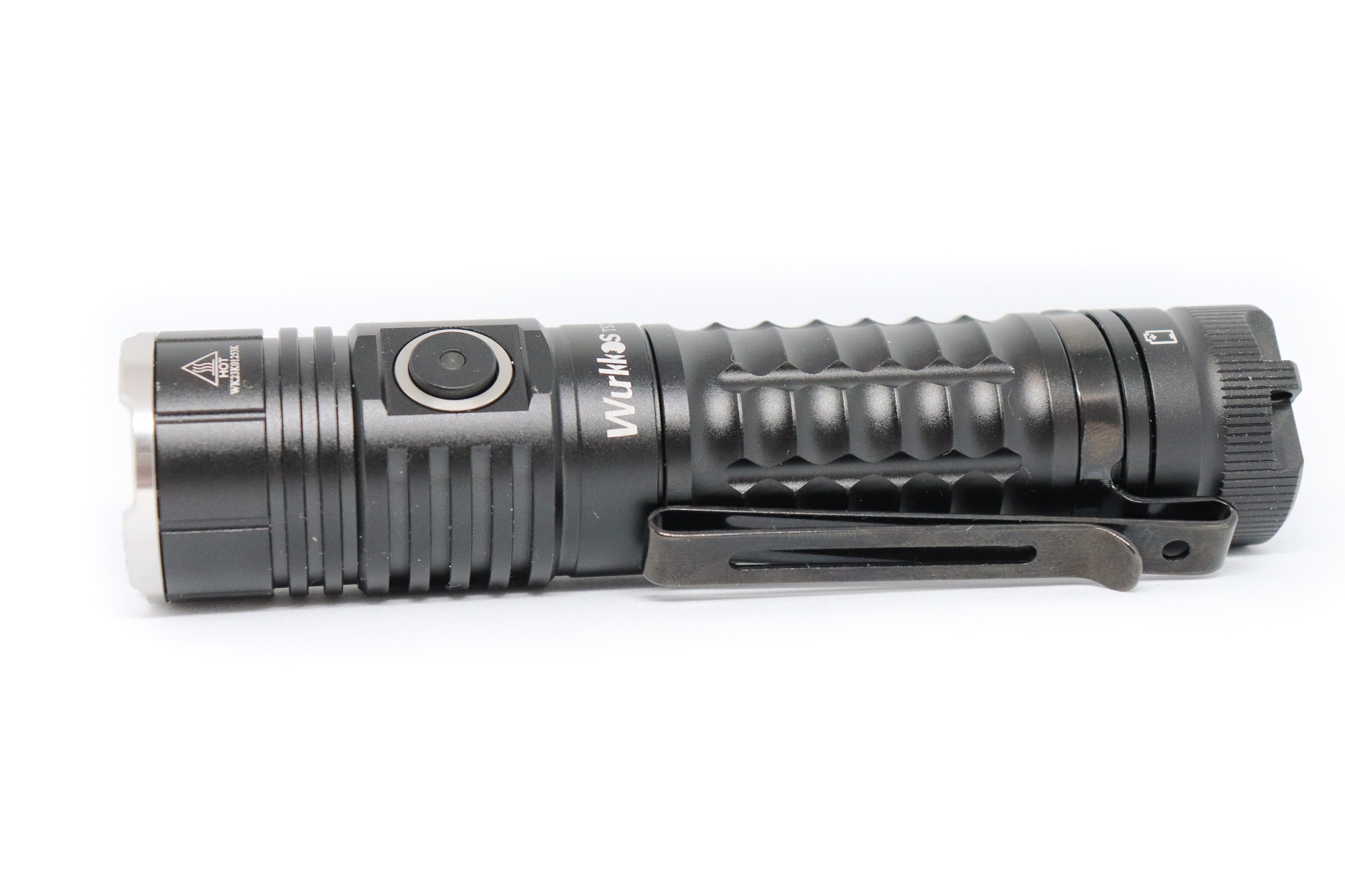
Wurkkos TS22 specs
| Brand & Model | Wurkkos TS22 |
|---|---|
| Flashlight category | EDC, general use, camping, outdoor |
| LED | ?? |
| Max. output | 4500 lumens |
| Max. beam distance | 191 meters |
| Max. beam intensity | 9150 cd |
| Battery config. | 21700 |
| Onboard charging | Yes |
| Main modes | E-L-M-H-T |
| Blinkies | Strobe |
| Waterproof | IP68 |
| Review publication date | December 2023 |
Review intro:
Having had a few Wurkkos lights in the past, I was quite keen to see what the TS22 was going to offer. On face value it looks like it should be a very good EDC light. I’m just hoping that they have got some of the finer details right and not just the headline specifications.
As an EDC light the TS22 looks to be ticking a lot of boxes with the design, form factor, high CRI LED and claims of good performance. Wurkkos offer the TS22 in black or green anodised form. I have the black one on test.
Sadly this review starts with some minor niggles and complaints. The Wurkkos website claims the TS22 has an XHP70.3 HI LED, yet the pictures show a light with an XHP70.2 LED. The included instruction manual also says XHP70.2, although it is clear to see the light supplied does indeed have the newer XHP70.3 HI LED. I understand mistakes can be made, but this is just sloppy and degrades buyer confidence, as you don’t really know what you are buying until you get it in your hands. Hopefully Wurkkos’ engineering team has made more effort than their marketing team has.
Package quality.
The TS22 comes in a nice presentation style retail box with a colour slipcover. I have some issues with the box however. Like the website it claims lumen and throw figures. But due to the ambiguity of the equipped LED, you have no idea if these performance claims are even possible, let alone valid.
To further this confusion the box claims the TS22 is equipped with an “XHP70D HICRI” LED, which just makes it more confusing as it doesn’t tally with the naming convention used on the website.
Once you slide the cover off the box you are presented with a high quality thick card box inside, held shut with magnetic catch and a high quality insert inside. This is nice, although one has to wonder if the development budget is being prioritised in the right areas. Hopefully the design & engineering of the light are able to match the effort and cost gone into the packaging.
Inside the box we have:
- The TS22 complete with attached double sided pocket clip
- A 21700 Wurkkos branded battery inside the TS22
- A magnetic tailcap
- USB-C cable
- Wrist strap
- 2 x spare o-rings
- Instruction manual
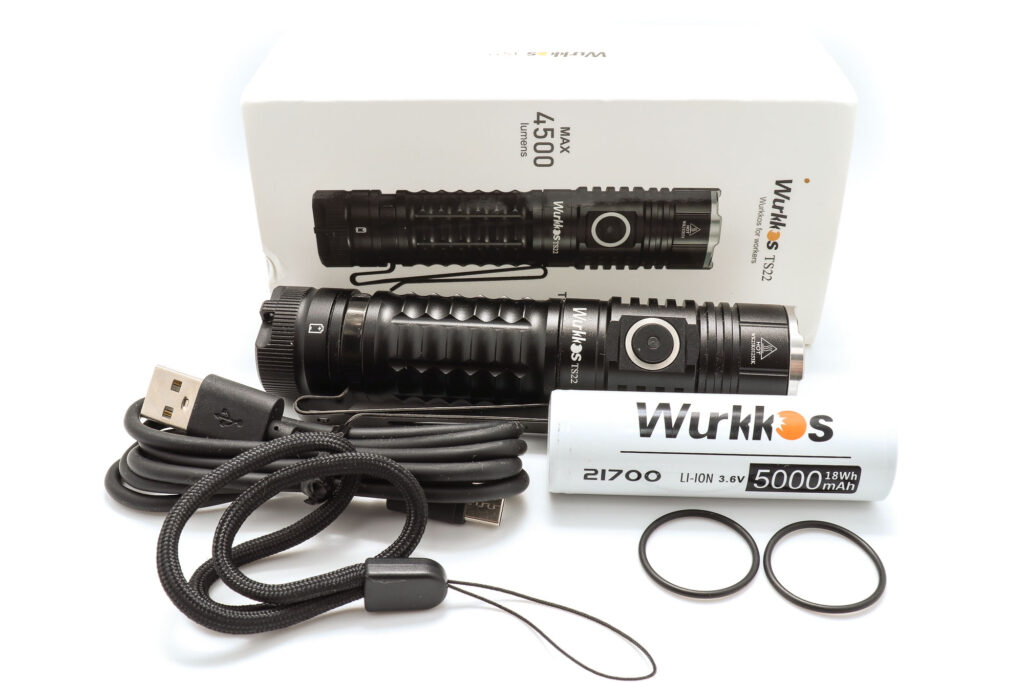
Flashlight in use, Build Quality, and Warranty
Wurkkos market the TS22 and an EDC flashlight for indoor or outdoor use. I would agree with this assessment, it is ideal for EDC and/or general flashlight duties.
The form factor is nice, albeit a little chunky being a 21700 powered light. It is noticeably bigger and heavier than an 18650 light would be and miles bigger than a 14500/AA light. The trade off being the much bigger capacity and runtime of a 21700 light. As well as more thermal mass and a power source able to sustain higher amp loads much better.
Aside from some UI niggles (which can generally be worked around) the TS22 is a nice EDC light and one I would happily carry and use.
My only real complaint here would be the knurling design on the body. It looks kinda cool and is somewhat unique, I don’t think I own another light with a knurling pattern like this. But it is very aggressive. The high ridges between the columns are really quite rough and unpleasant in the hand. Grippy, yes. Just not very nice to interact with. It isn’t a deal breaker and I can overlook this when considering the entire package and offering. But it is a shame this wasn’t refined during the R&D process.
The TS22 also comes with a magnetic tailcap. I have to say, I really like the idea of a magnetic tailcap, although the reality is, I find I end up with very little opportunity to make use of such a feature. That said, it is good it is offered and apart from occasionally snagging my keys with it, it causes no harm having it as a feature.
The general build quality of the light also appears to be great. Overlooking the knurling design, there are no other rough or sharp edges anywhere. The anodising is flawless and everything fits and works really well.
The pocket clip is of a good design and allows for deep pocket carry and feels secure to use.
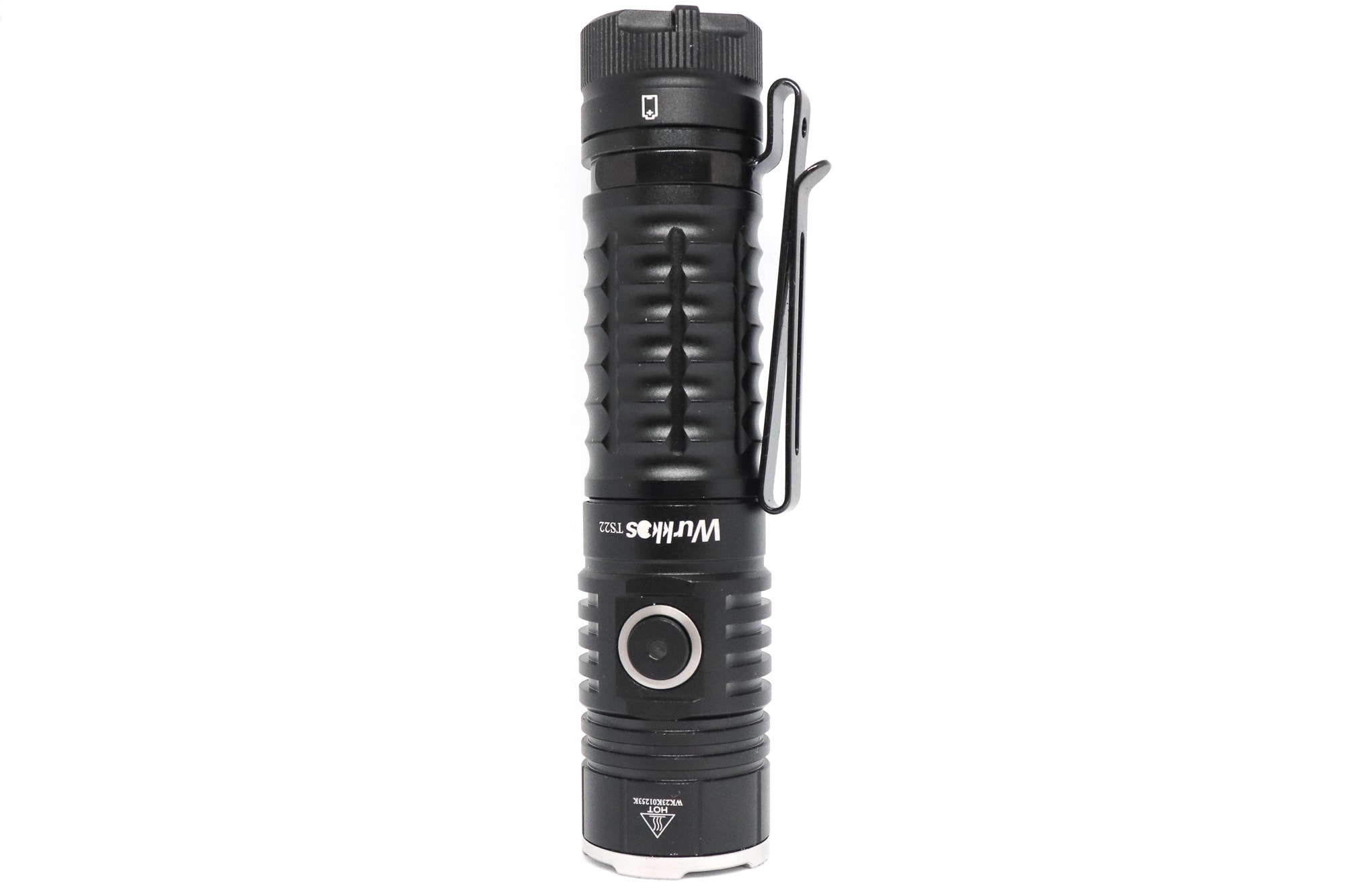
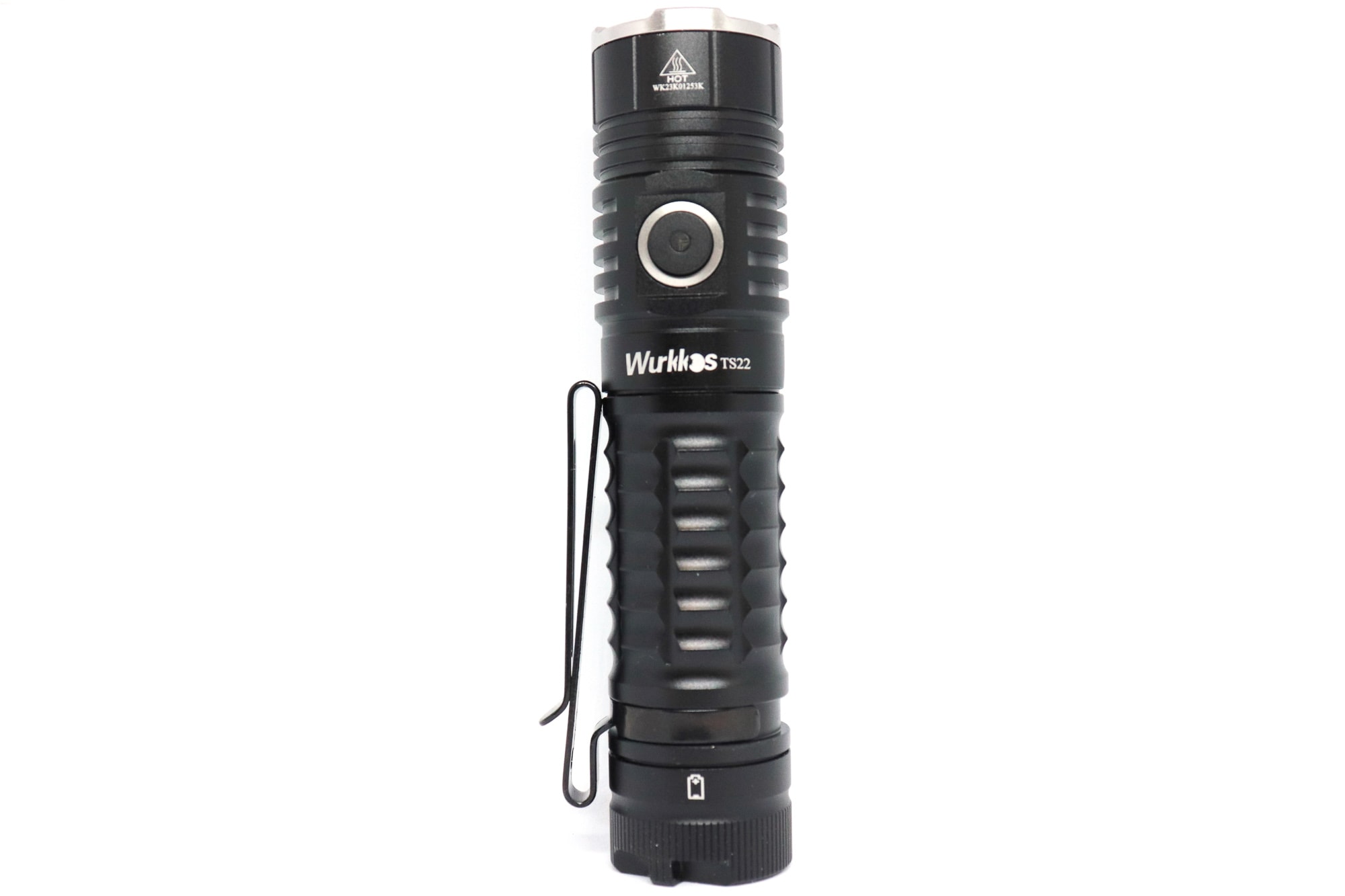
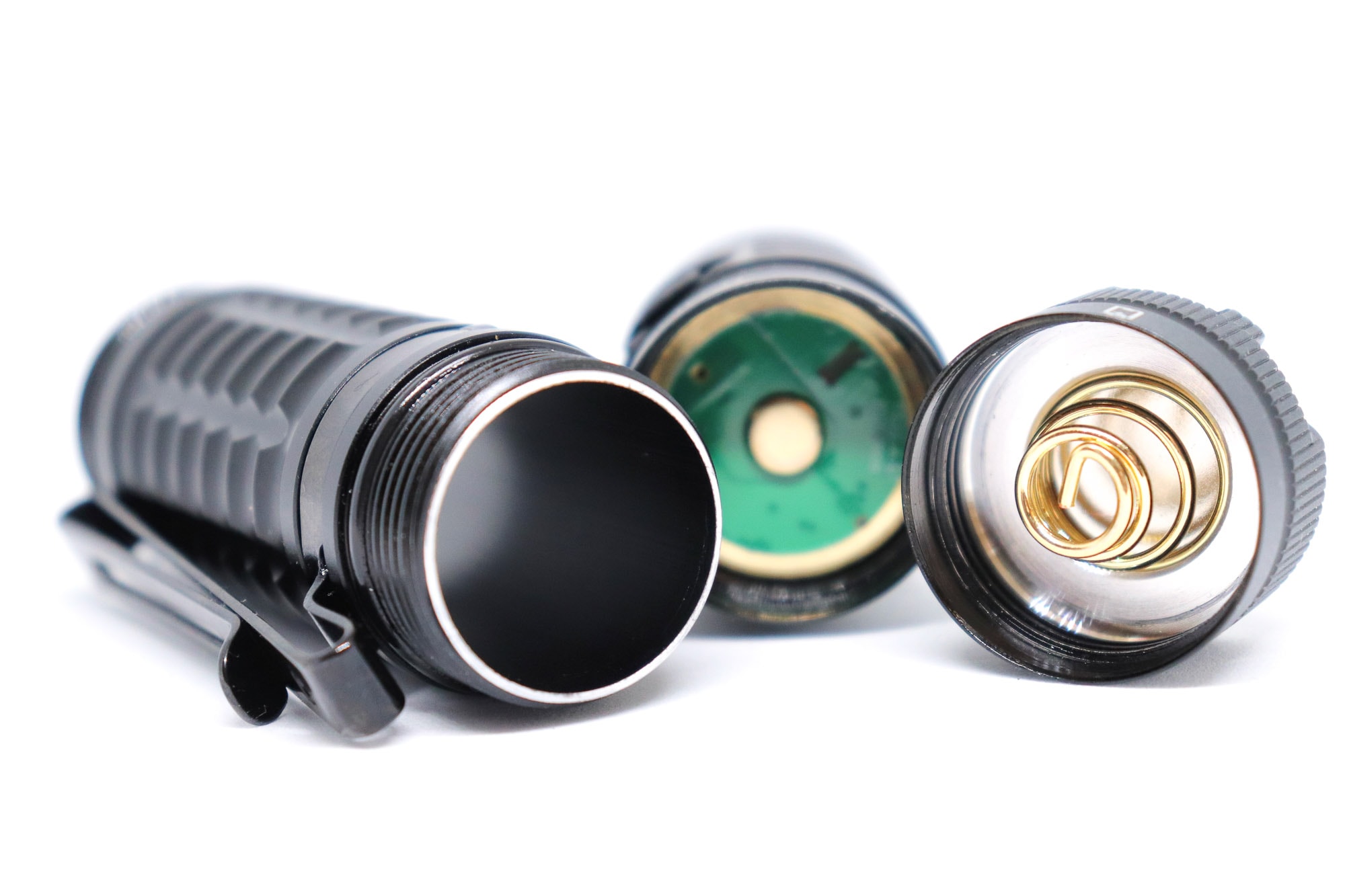
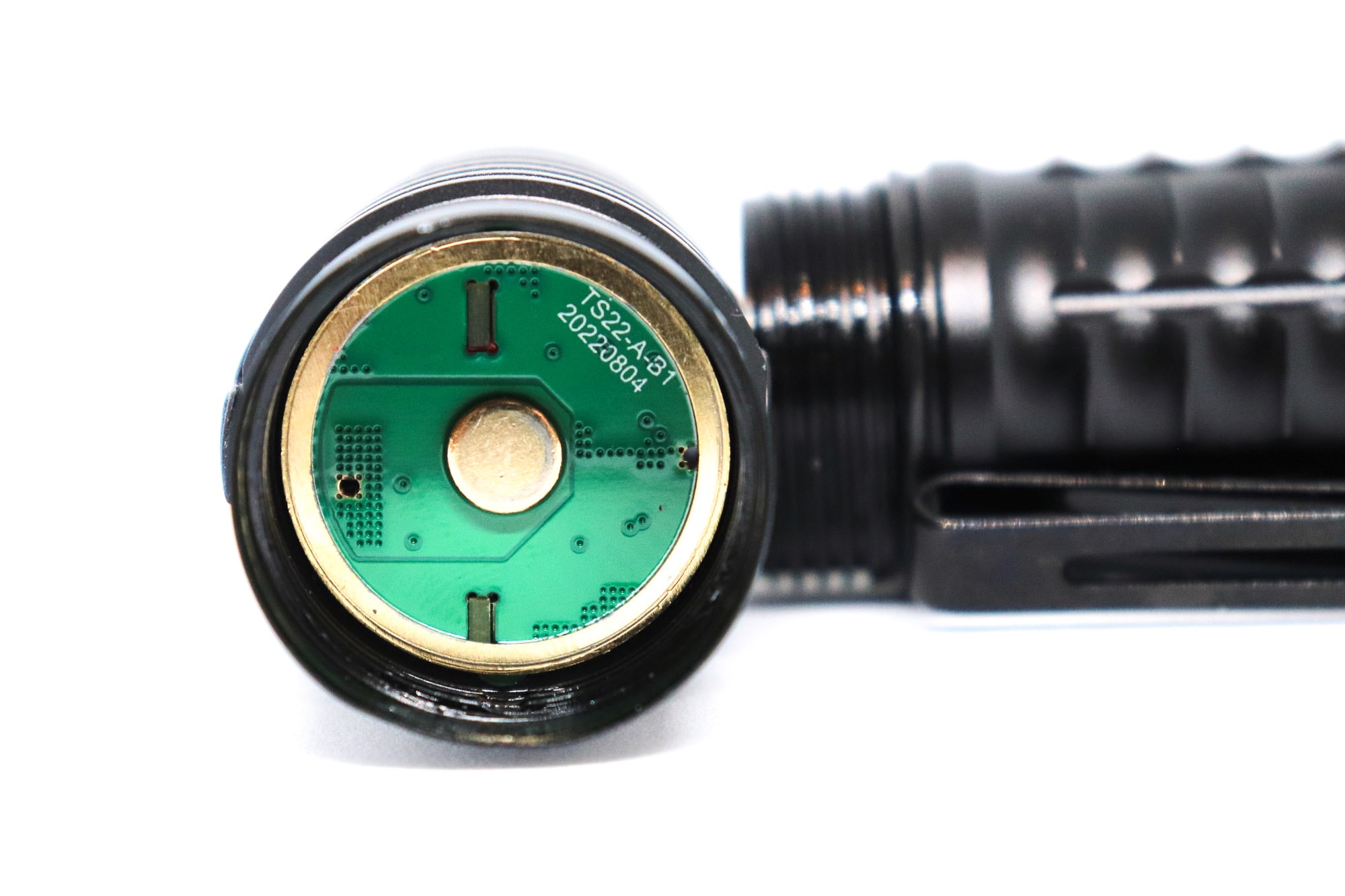
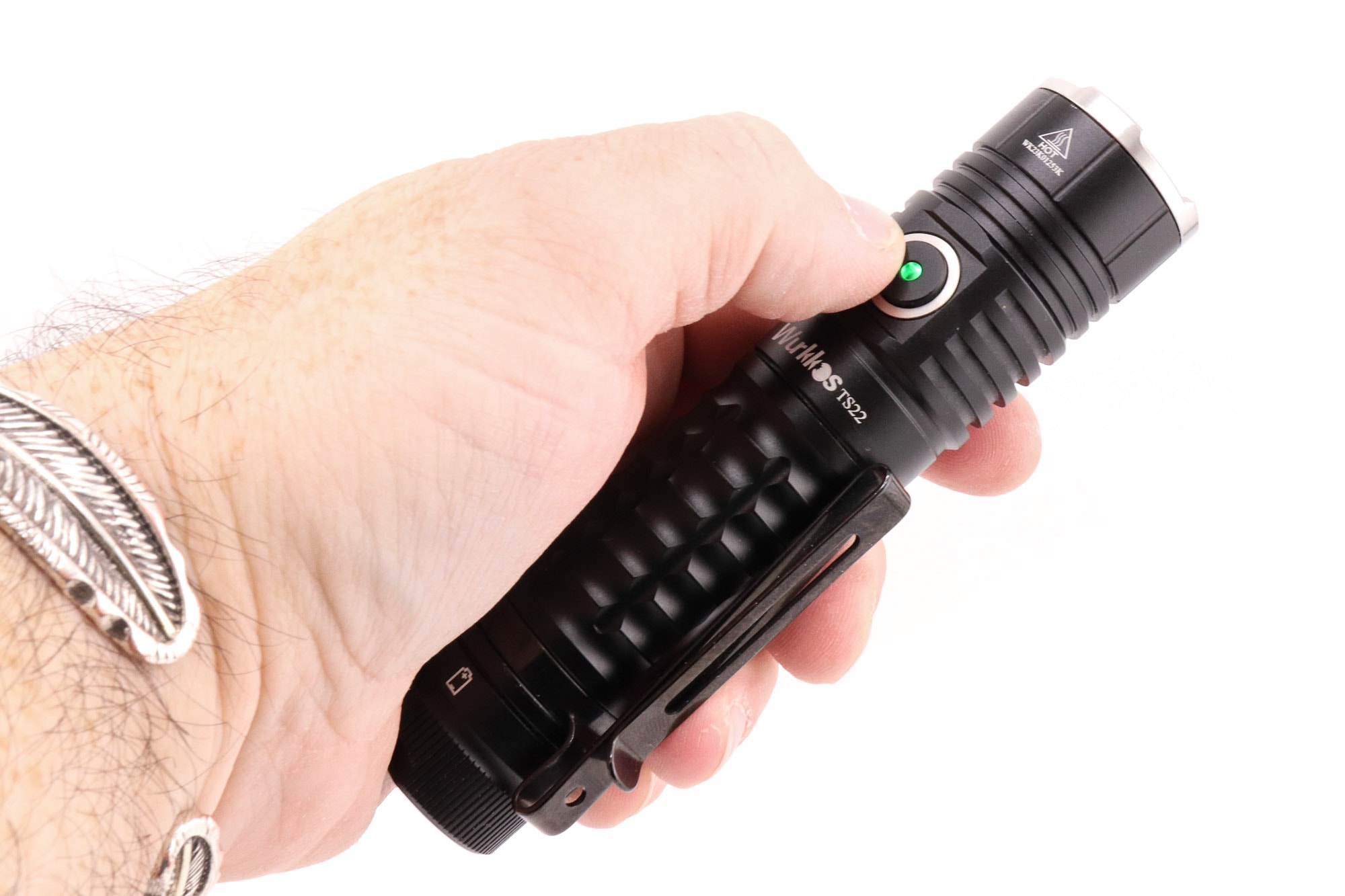
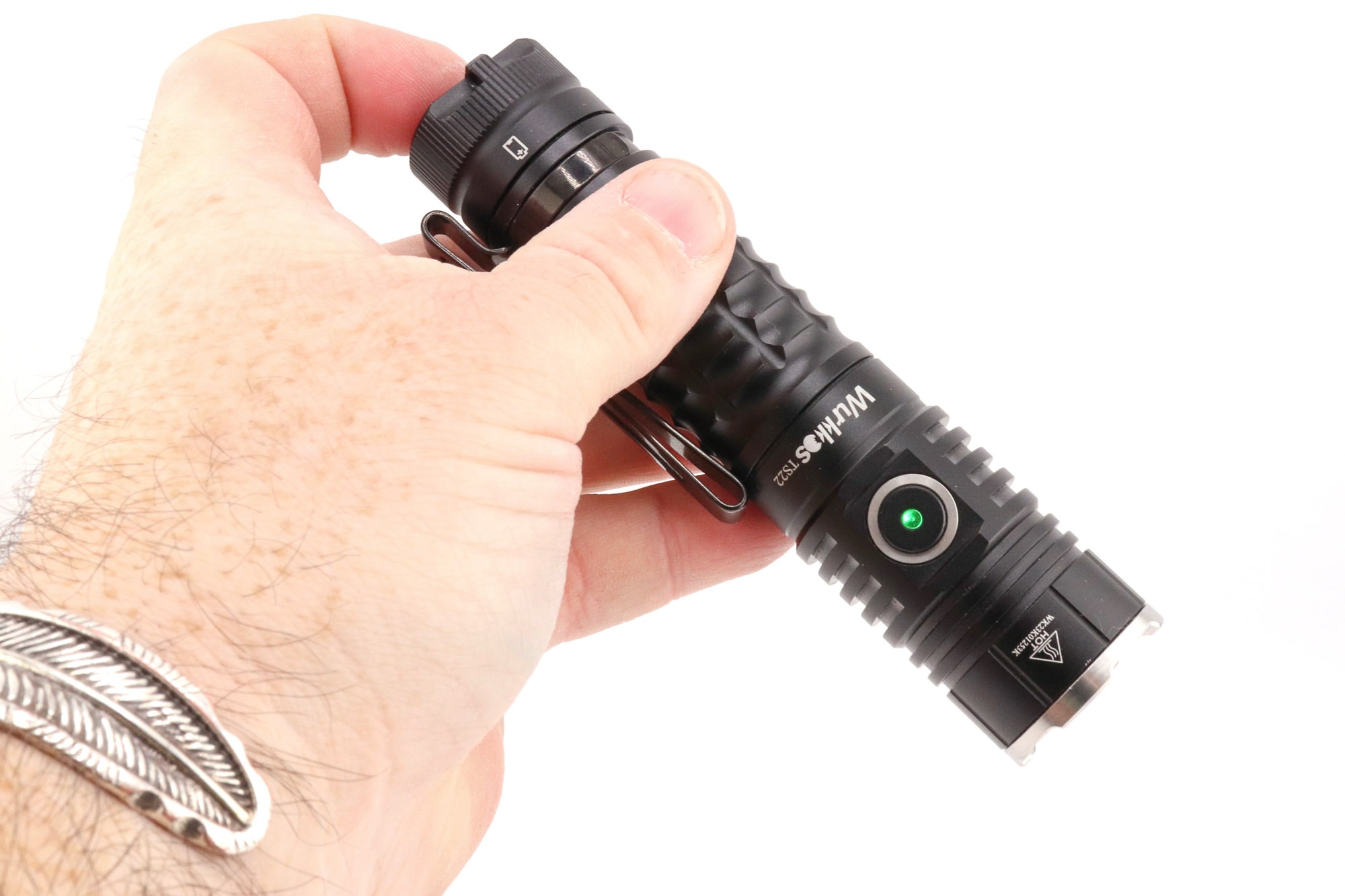
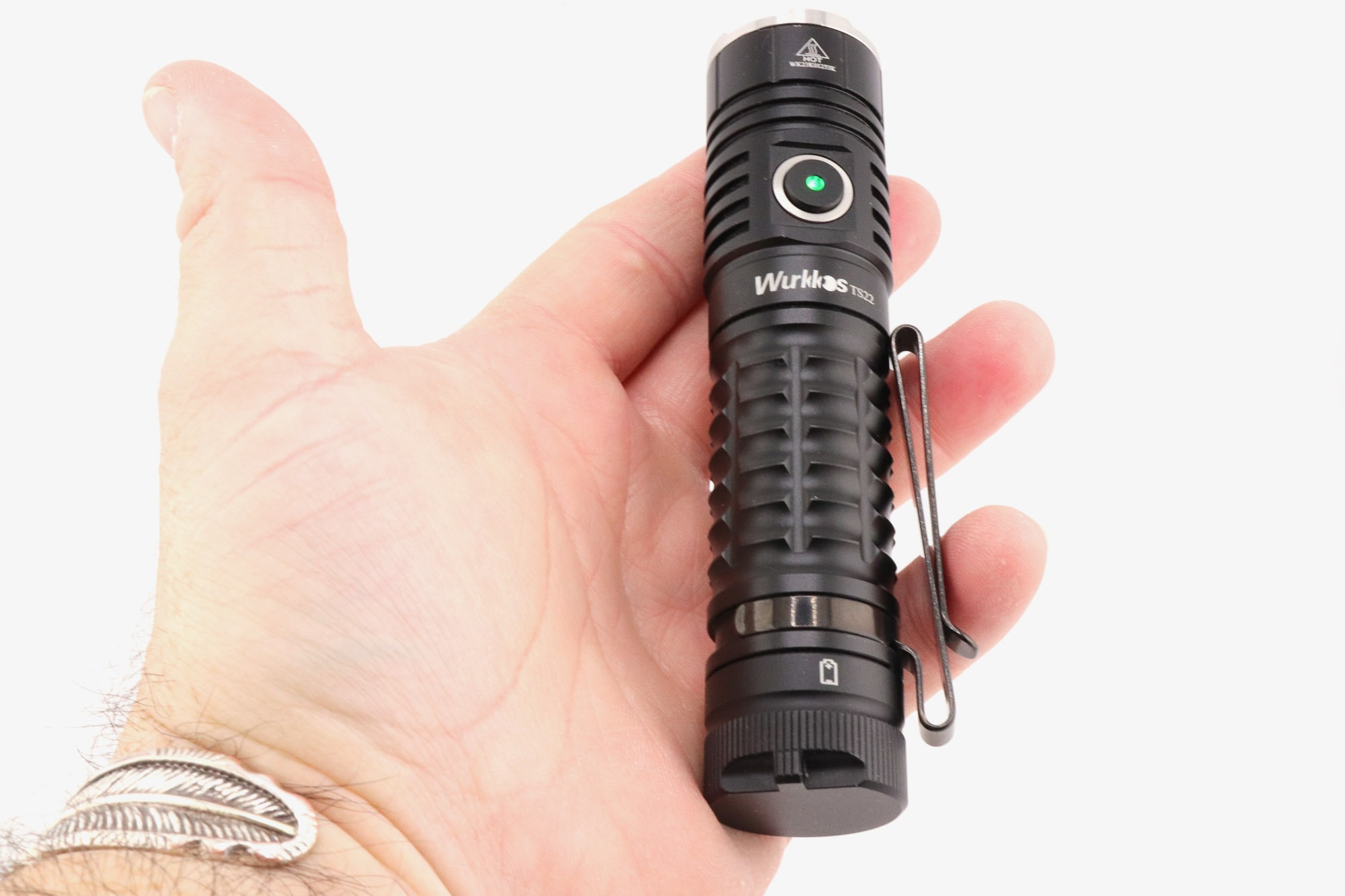
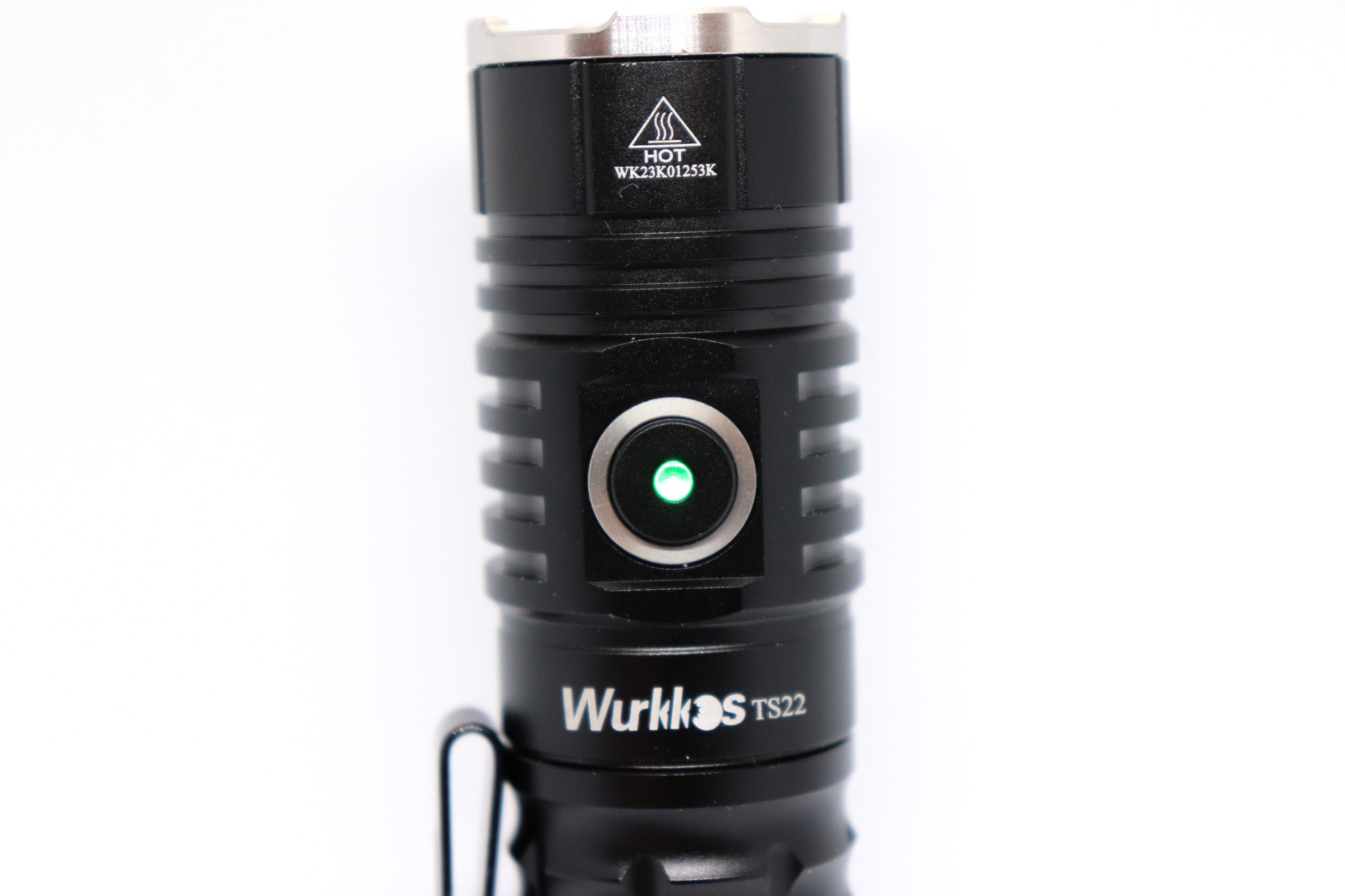
LED, Lens, Bezel, Beam, and Reflector
As discussed above, there seems to be unnecessary confusion over what LED the TS22 should have or comes equipped with. I can confirm it is indeed the XHP70.3 HI LED. This is a large domeless LED, so is easy to distinguish from the domed XHP70.2. This does however lead me to believe that all of the lumen and throw claims are completely wrong and are probably for the XHP70.2 LED rather than the LED it actually comes equipped with.
The box claims the LED should be 4700-5300k and 90CRI. In person I’ve found I’m a little undecided about the beam. In isolation in the dark when you have no other light sources nearby, it seems really nice and neutral. But if you compare it to other High CRI lights or ones with warmer tints, the light has a bit of an odd quality, almost as if someone has turned the colour dial down or something. I really couldn’t quite place my finger on what was happening. It isn’t so much a green or blue tint, maybe more of a grey one??
I am being a little picky here. The beam is really quite good, but I am currently EDC’ing a light with a 4000k 95CRI SST-20. And I was expecting the XHP70.3 to maybe be closer to it in terms of tint. If you compare the TS22 to a much cooler light, such as the Wurkkos TD02 I reviewed a while back, the XHP70.3 HI does indeed look much nicer.
At the business end of the TS22 we have an AR coated glass lens and a nice crenulated stainless steel bezel, with nice smooth machining. The reflector is a Heavy Orange Peel (HOP), with the domeless XHP70.3 HI sitting behind the opening. The large LED and moderate sized reflector offer a very nice beam.
It has a massive hot spot and a slightly smaller in diameter spill beam than you might expect. This gives a very nice even bright floody beam. More akin to a triple reflector/LED setup or some TIR optics. I really can’t stress just how nice the beam profile is. Many lights have a large difference in luminance between the hot spot and spill beam. On the TS22 this gap is much smaller and the large hot spot makes up a bigger percentage of the area being illuminated. Giving you a very nice flood beam with very bright illumination.
Despite the beam appearing to be a superb flooder for close up work. I must also highlight that it throws well too all things considered. Given we have a HOP reflector and a relatively large LED to reflector size ratio. I was not expecting it to have such a good beam distance. The domeless XHP70.3 HI is certainly living up to the High Intensity (HI) part of its description.
Spectral measurements:
I used an Opple Light Master to measure the flashlight at 3 metres distance.
| Mode: | CCT: | CRI Ra: | duv |
|---|---|---|---|
| Turbo | 4974K | 91.3 | 0.0061 |
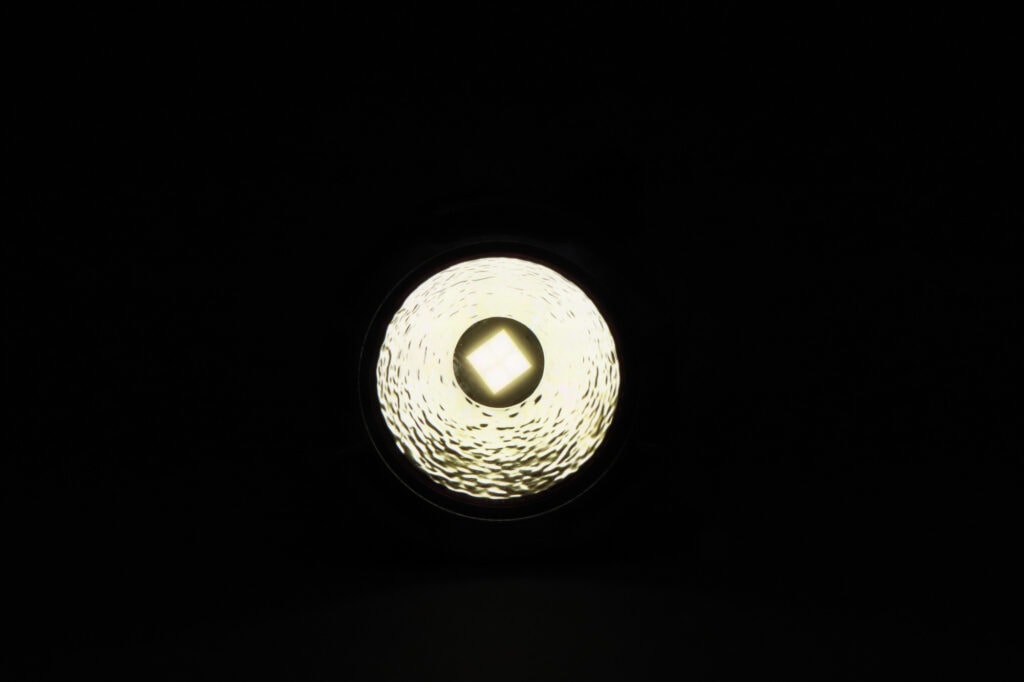
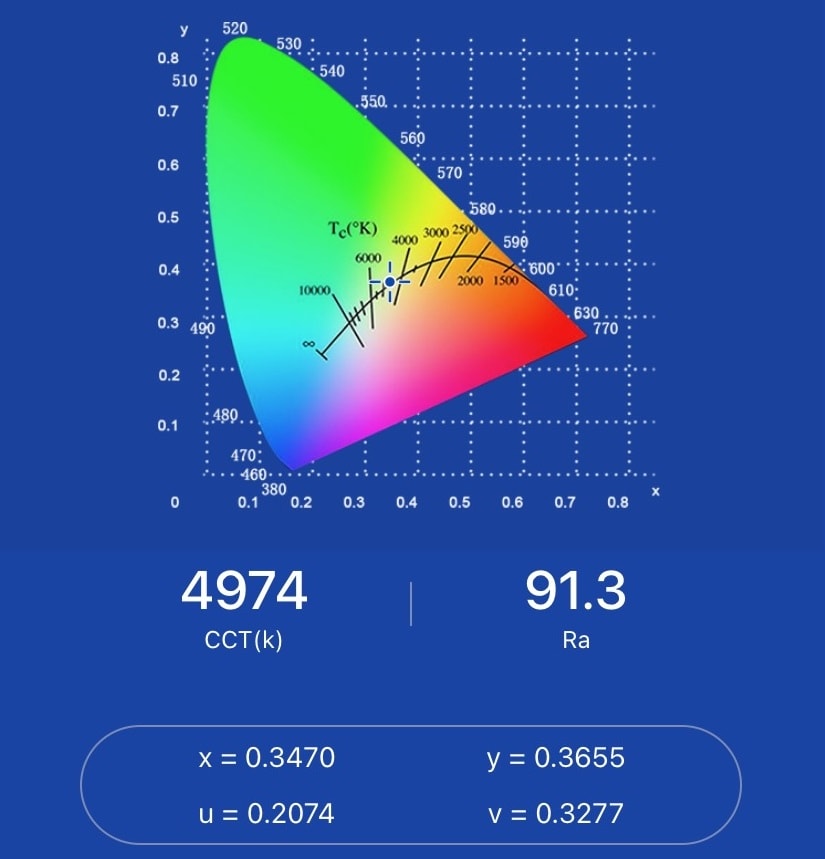
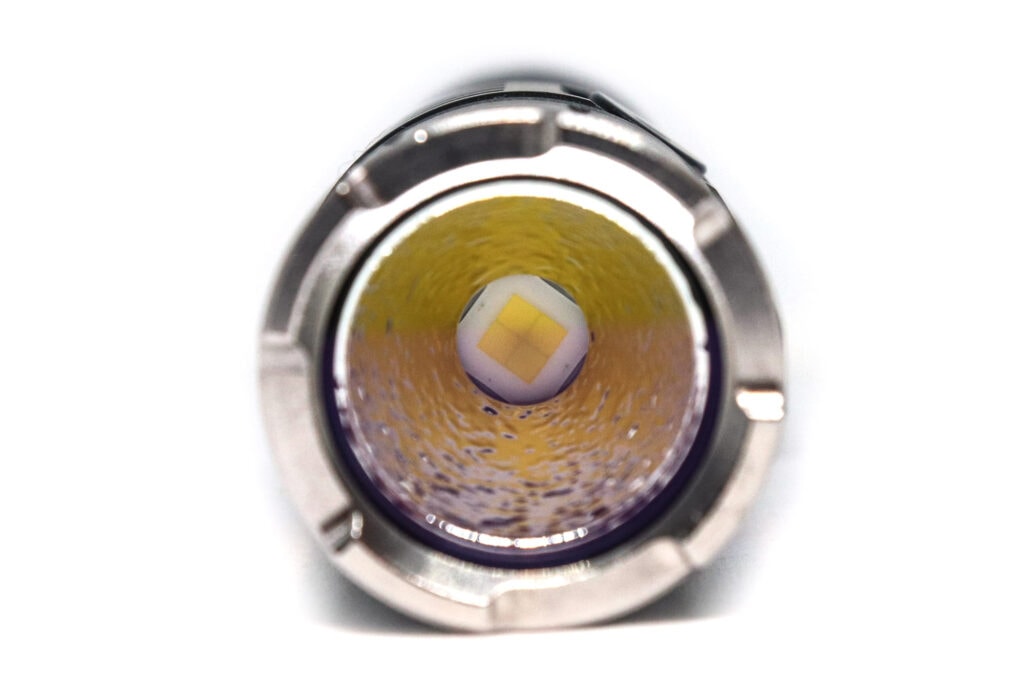
Dimensions and its competition
Dimensions:
| Wurkkos TS22 | Millimetres | Inches |
|---|---|---|
| Length | 122mm | 4.80 in |
| Head diameter | 28mm | 1.10 in |
| Body diameter | 28mm | 1.10 in |
Dimensions are rounded to the nearest millimetre, and to the nearest tenth of an Inch.
Weight:
| Wurkkos TS22 | Weight in grams | Weight in oz |
|---|---|---|
| Without battery: | 95g | 3.35 oz |
| With battery | 164g | 5.78 oz |
Weight is rounded to the nearest gram, and to the nearest tenth of an Oz.
Flashlight size comparison with its competition:
Group 1: Emisar D1K, Wurkkos TS22, Speras E21, Zerbralight SC600w IV Plus
Group 2: Convoy S2+, Wurkkos TS22, Wurkkos TD02, Manker EC01
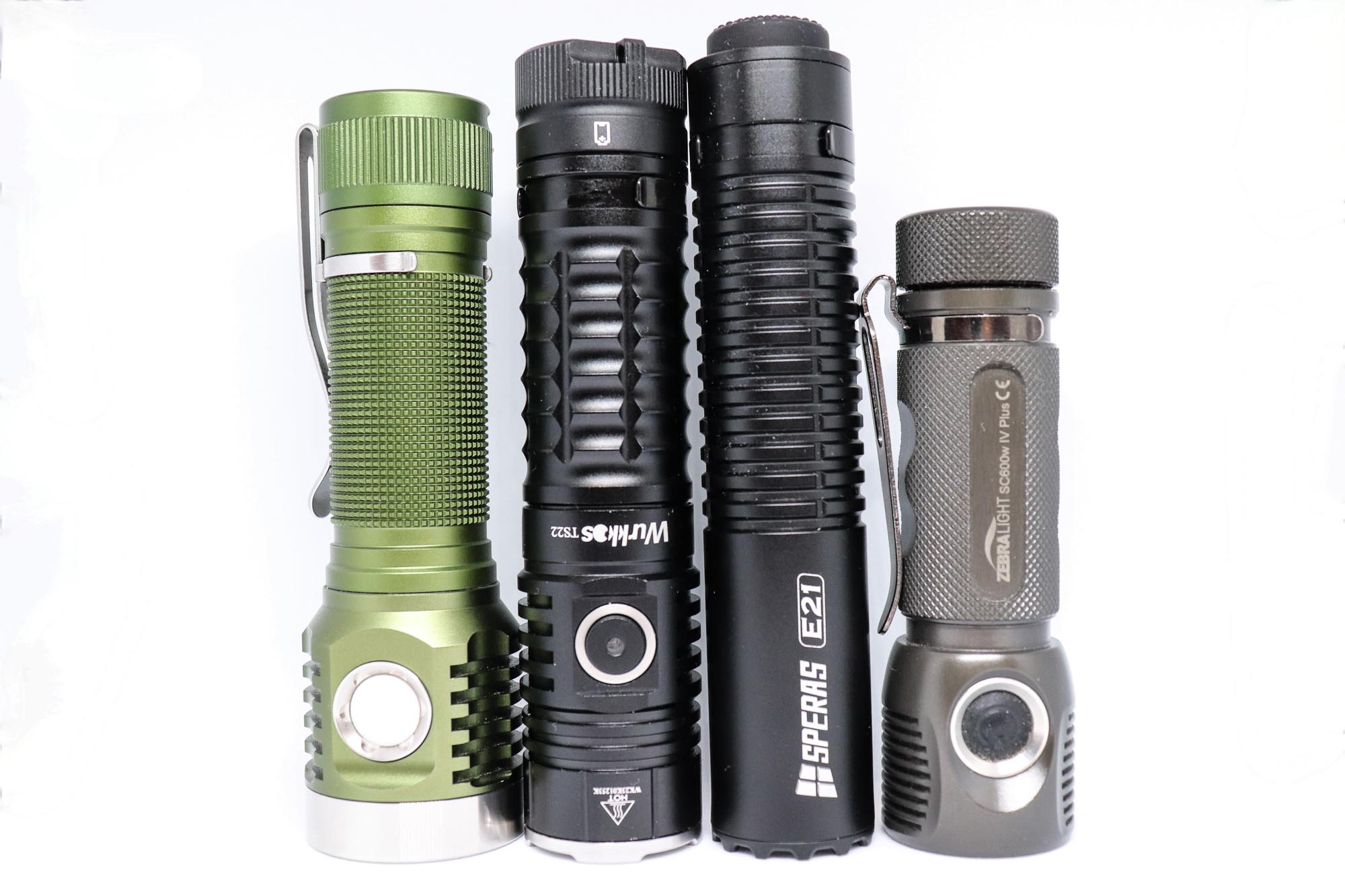
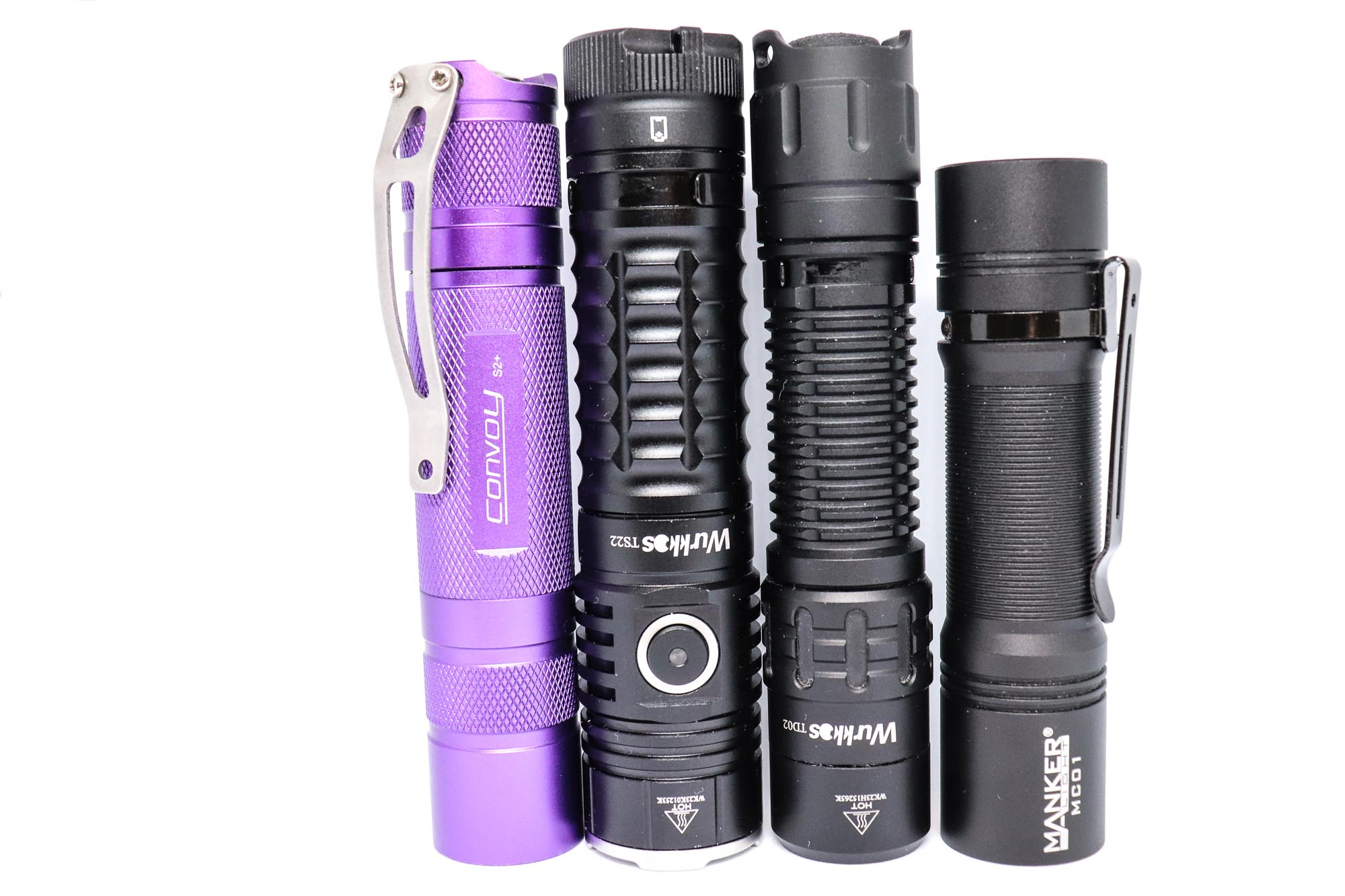
Wurkkos TS22 UI: User Interface and Driver
The TS22 has a switchable UI to offer either a stepped output mode or a seamless ramping mode. I much prefer the ramping mode to use, although it is by default programmed to the stepped mode and this makes it easier to measure performance at preset outputs, so all testing has been done with it in the stepped UI mode.
Stepped Mode
Available modes:
- Eco Low, Medium, High, Turbo
Available blinky modes:
- Strobe
From OFF:
- Press and hold: Eco
- Single click: On (last mode memory)
- Double click: Turbo
- 3 fast clicks: Strobe
- 4 fast clicks: Lock (and 2 clicks to unlock)
From ON:
- Press and hold: Scroll modes
- 1 click: off
- 1 click if in Turbo: back to last mode output
- Double click:Turbo
- 3 fast clicks: Strobe
- 4 fast clicks: Switch between Stepped and Ramping UI’s
Ramping Mode
Available modes:
- Eco, Low, Ramping , High ,Turbo
Available blinky modes:
- Strobe
From OFF:
- Press and hold: Eco
- Single click: On (last mode memory)
- Double click: Turbo
- 3 fast clicks: Strobe
- 4 fast clicks: Lock (and 2 clicks to unlock again)
From ON:
- Press and hold: Ramp up or down in brightness
- 1 click: off
- 1 click if in Turbo: back to last mode output
- Double click:Turbo
- 3 fast clicks: Strobe
- 4 fast clicks: Switch between Stepped and Ramping UI’s
Mode memory:
- Yes
Shortcuts:
- To Low: No, but there is Eco
- To Turbo: Yes
- To Strobe: Yes
Low voltage warning/protection:
- Yes
Strobe/blinkies
- Strobe
Lock-out mode:
- Yes, manual and automatic plus physical with tailcap. 4 clicks to lock when Off, and 2 clicks for unlock.
PWM
- None that I can detect
Additional/summary info on the UI:
I have to say I rather like the UI. It is certainly one of the better ones out there. But it has a few very odd and annoying design decisions.
Firstly, the ramping mode is in my opinion the way to use the light. It is much more natural and easy to use. The stepped mode is largely the same, just with pre-programmed output levels. But for some reason when you have set output modes, it always feels unintuitive to click and hold to advance through them. So I always end up single clicking and turning the light off by mistake.
When in ramping mode my brain copes much better and it feels completely natural to click and hold to change the output.
The ramping is quite good, maybe a tad too quick, but very usable. The Eco setting could do with being lower, it seems far too bright in my opinion. I’d much prefer a more true Moonlight mode instead.
One thing I do not like however, is that the light behaves differently with the same user action. If you turn on in Turbo with a double click. Or are using any other output mode, a single click turns the light Off. This is sensible and nice to use. But if I turn the light on then go to Turbo, a single click now doesn’t turn the light off and instead reverts to your previous output. I find this trait hugely annoying.
However, the most annoying trait is the automatic locking. By default the light will lock itself after a couple of mins. Clicking the switch now results in a double flash and it doesn’t turn on. So you have to click 2 times to unlock the light, it then automatically turns on in the last used mode!!!!!! ArrrrgGHHHH!!!! The auto locking also completely disables the use of the shortcuts to the Eco and Turbo modes too. I really do wonder how people come up with such conflicting user interfaces that make no sense. A trait such as this is enough for me to consign a light to being a paper weight or a shelf queen. Thankfully there is a hacky workaround that allows the light to be used without huge irritation.
The side switch has a Green/Red LED light, this is used as a battery monitor and charging light. However, if you click 5 times when the TS22 is off, it will turn the green switch light on permanently. You have to read the instruction manual very well to find this out, as it is not in the operation or modes section, but under the power indicator section.
The good news here is, when you turn the green light on, it disables the annoying auto locking feature. Hooray!!!
If I’m being honest, I do not understand why this green indicator light should have any connection to the auto locking feature. But I’m pleased it enables me to disable it.
Why Wurkkos couldn’t have included a way to disable it separately I have no idea. But it makes for a hacky workaround to a major UI problem. The only downsides are, the green LED is actually really quite bright and even a little dazzling in low light should you shine it in your eyes. It also makes the light less suitable to keep by the bedside as I find the green light way too bright and obtrusive. I guess I could stick some tape or glue over it to dull it down. And in theory the green LED will produce more static drain when you aren’t using the light. However, these trade-offs are completely acceptable for disabling the auto locking.
I would also like to note that I have carried the TS22 as an EDC light throughout the writing and testing of this review. It has never once activated in my pocket, despite disabling the auto lock feature. Meaning that the side switch is of good design and raises the question why someone at Wurkkos ever thought that it needed the auto lock function at all.
Wurkkos TS22 Charging and batteries
The included Wurkkos battery seems to be up to the task of powering the TS22 without issues. It is a snug fit in the battery tube, but no issues with removing or reinserting it. The battery is of flat top design and there is a spring only on the tailcap contact of the TS22, with just a stud contact at the driver board end.
Charing is easy with the supplied USB-C cable and uses the switch LED to indicate charging state.
| Charge type | Fits | No fit | Charge time |
|---|---|---|---|
| Flashlight with onboard USB-C | All 21700 sizes | ? | 3hr 55min from shutoff to fully charged at 4145mAh |
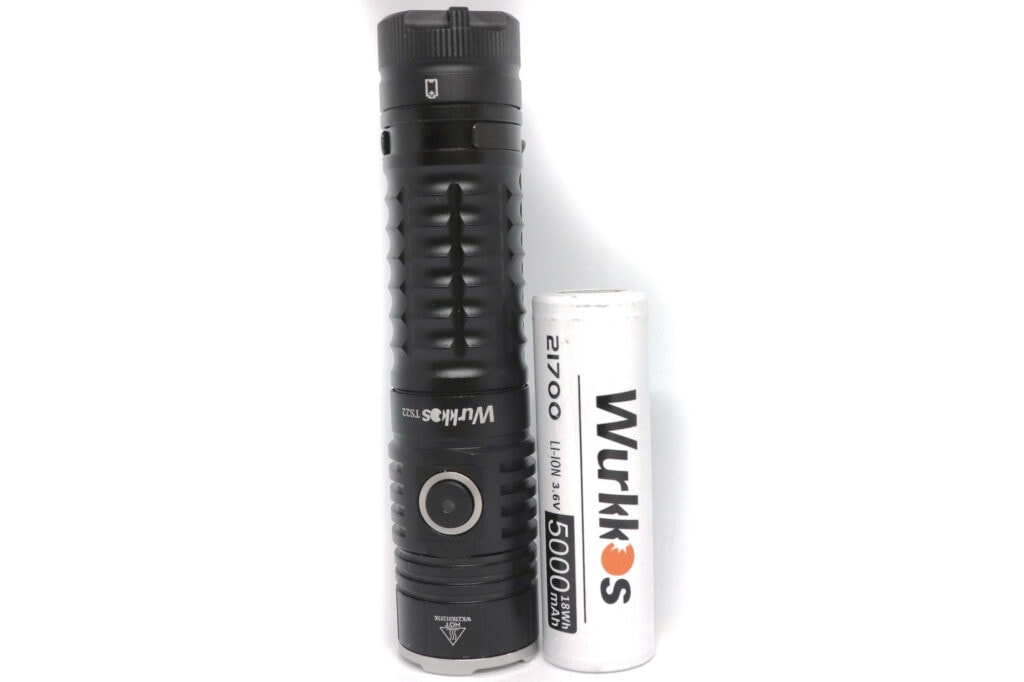
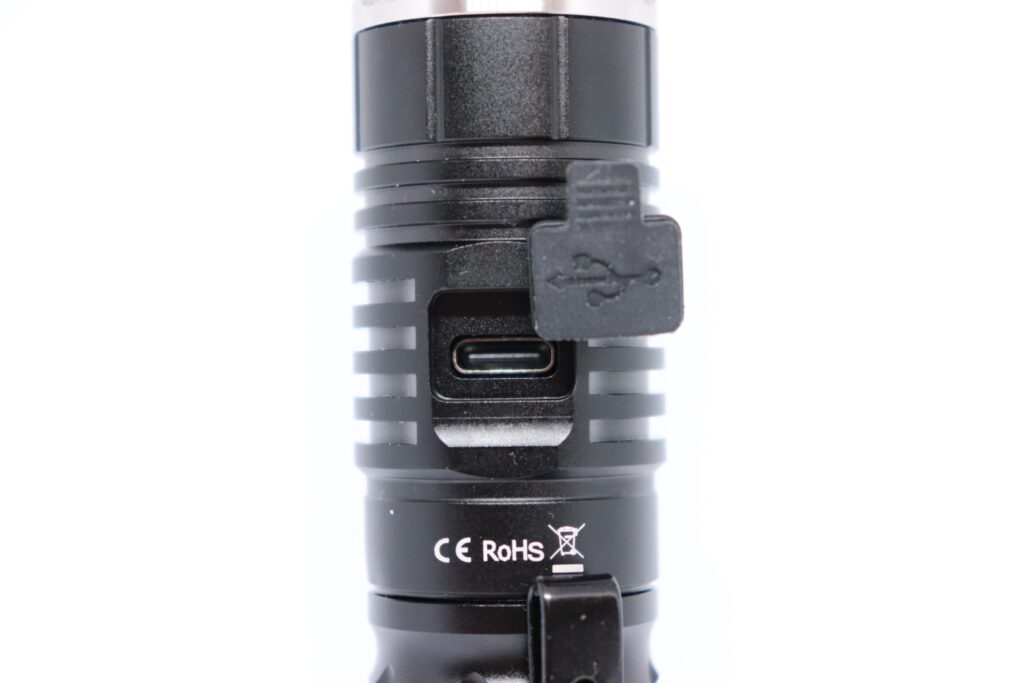
Performance test
Lumen measurements
How Lumens are Measured: Understanding ANSI FL1 Standards How Lumens are Measured: Understanding ANSI FL1 Standards: The ANSI FL1 standards specify that output in lumens should be measured 30 seconds after turning on, as this is the standardized time for measuring brightness according to the industry standard. This is why we focus on this part in our measurements. The ANSI FL1 standards require an ambient temperature of 22 ± 3°C. We record the ambient the ambient temperature to identify potential reasons for any observed discrepancies.To test the performance I use a homemade integrated sphere for lumen testing using a dedicated light metre. I also use the CeillingBounce Android app for measuring throw and runtimes. Both are calibrated using a 1Lumen supplied calibration light.
As mentioned earlier, I do have concerns that the output claims and performance are not accurate from Wurkkos, due to the ambiguity over what LED the light is meant to have. The results would tally with this. As generally the domeless HI LEDs offer more throw and less lumens than their domed counterparts. We can clearly see the TS22 has fallen short on lumen output, but massively exceeded the claimed throw numbers.
Overall I’m very pleased with the performance and despite the mismatch in numbers you won’t feel short changed. I also personally would happily trade a few lumens for better throw.
| Mode | Amps at start | Specified | 0 sec. | 30 sec. | 10 min. |
|---|---|---|---|---|---|
| Eco | 0.04 | 10 | 8 lm | 8 lm | 8 lm |
| Low | 0.15 | 100 | 65 lm | 65 lm | Not tested |
| Med | 0.83 | 500 | 385 lm | 385 lm | 383 lm |
| High | 4.15 | 1800 | 1443 lm | 1435 lm | 667 lm |
| Turbo | 14.78 | 4500 | 3159 lm | 2986 lm | 672 lm |
Parasitic drain:
- 0.01A (with the green side light on)
Wurkkos TS22 Battery Life: Runtime graphs
How Runtimes are Measured: Understanding ANSI FL1 Standards About ANSI FL1 runtime standards: The runtime is measured until the light drops to 10% of its initial output (30 seconds after turning on). This does not mean that the flashlight is not usable anymore. The last column shows how long the light actually works till it shuts off. If there is a + symbol, it means that the test was stopped at that particular point, but the light was actually still running. This happens on certain occasions, with certain drivers, firmware, or batteries.Wurkkos claims the TS22 has Advanced Temperature Regulation. I’m not convinced I could see evidence of this during the runtime tests. However the general regulation of the light seemed to be very good.
| Mode | Specified | Measured runtime ANSI | Time till shut off |
|---|---|---|---|
| Eco | 280h | Not tested | Not tested |
| Low | 24h | Not tested | Not tested |
| Med | 4h 30min | 6h 5min | 6h 5min |
| High | 1h 48min | 3h 2min | 3h 2min |
| Turbo | 1h 30min | 3h 2min | 3h 2min |
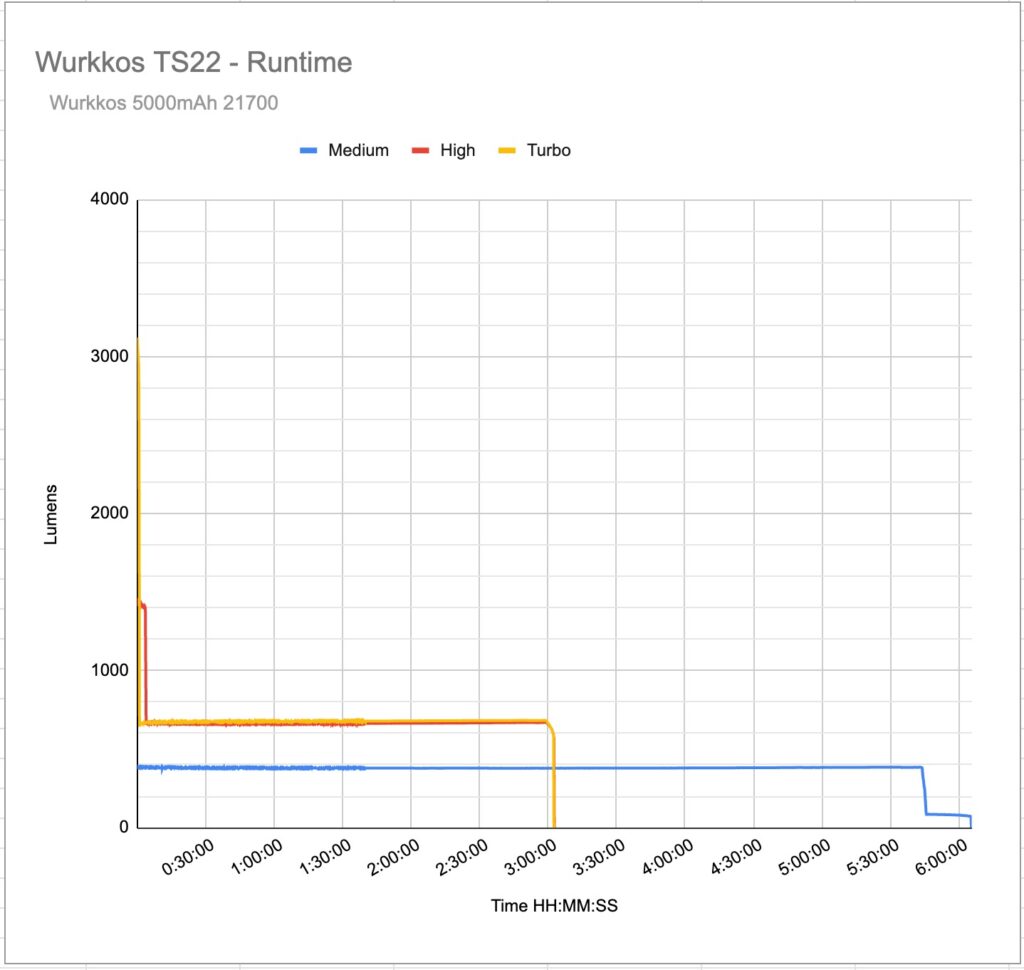
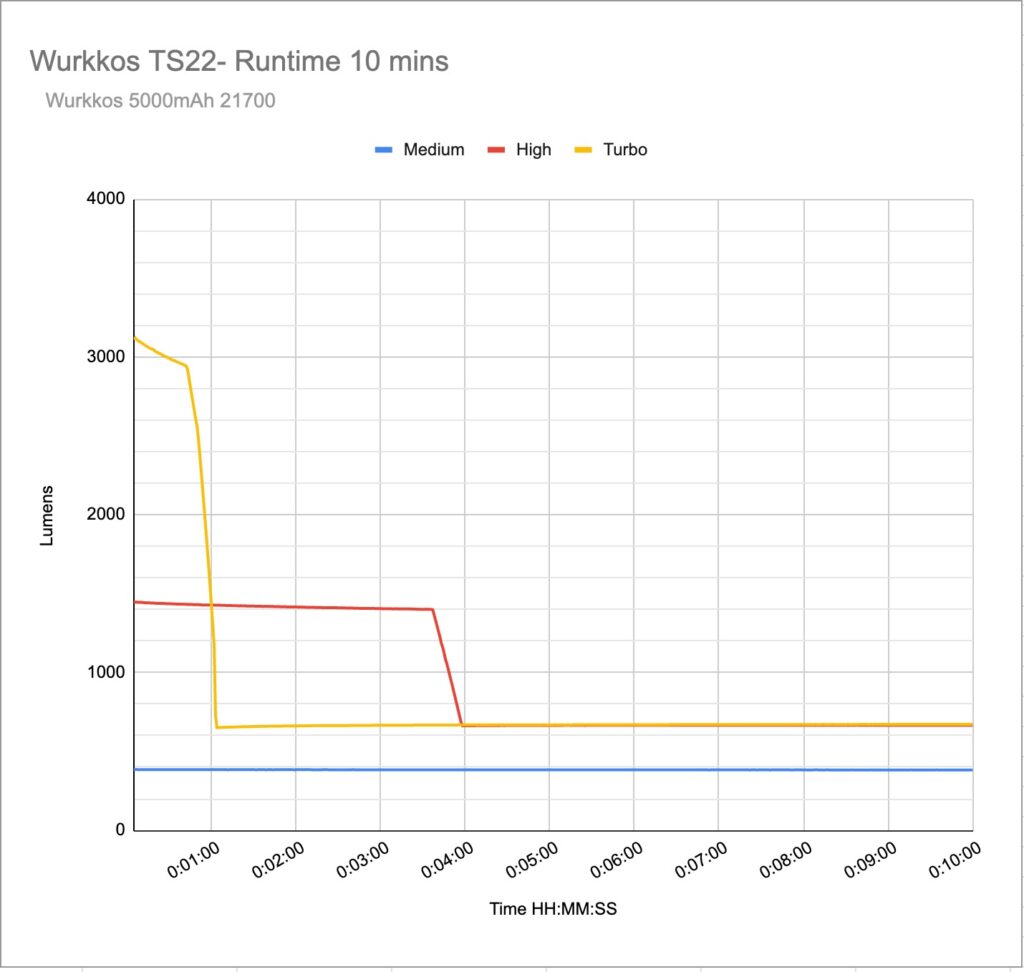
Peak beam intensity and beam distance measurements
About Peak beam intensity: Understanding ANSI FL1 Standards About peak beam intensity The calculated value of distance in meters at which the flashlight produces a light intensity of 0.25 lux. (0.25 lux is about the brightness of a full moon shining on an object). This means that the intensity has decreased so much, it becomes difficult to see darker objects, or objects that don’t reflect light. The columns ‘Meters’ and ‘Yards’ use rounded numbers.| Mode | Specified | Candela measured | Meters | Yards |
|---|---|---|---|---|
| Eco | 23cd / 9m | 35 cd | 12 m | 13 yd |
| Low | 178cd / 27m | 298 cd | 35 m | 38 yd |
| Medium | 1050cd / 65m | 1,759 cd | 84 m | 92 yd |
| High | 3775cd / 124m | 6,866 cd | 165 m | 180 yd |
| Turbo | 9150cd / 191m | 14,486 cd | 241 m | 264 yd |
Beamshots
Camera settings and distance:
Camera: Canon EOS 200D DSLR, Canon 18-55mm EFS IS at 18mm, Shutter: ¼, Aperture: F4.5, ISO: 1600, White Balance: 5200k
To take the photos the camera and torch are both mounted to a tripod using a timer on the shutter. Beam shots are taken at two different distances.
Distance: 100m to the building
Distance: 5m to the tree on the left and 11m to the compost heap
Beamshots of the following flashlights compared:
- Wurkkos TD02 (SST-40)
- Convoy S2+ (Osram W1)
- Emisar D1K (SST-20 95CRI)
- Speras E21 (SST-40)
Please note that beamshots are mainly intended to showcase the beam pattern and beam quality, rather than overall performance. These images are typically taken directly after activation, and do not fully represent its overall performance. For accurate performance metrics, such as output, beam distance, and runtimes, you need to look at the performance section of this review.
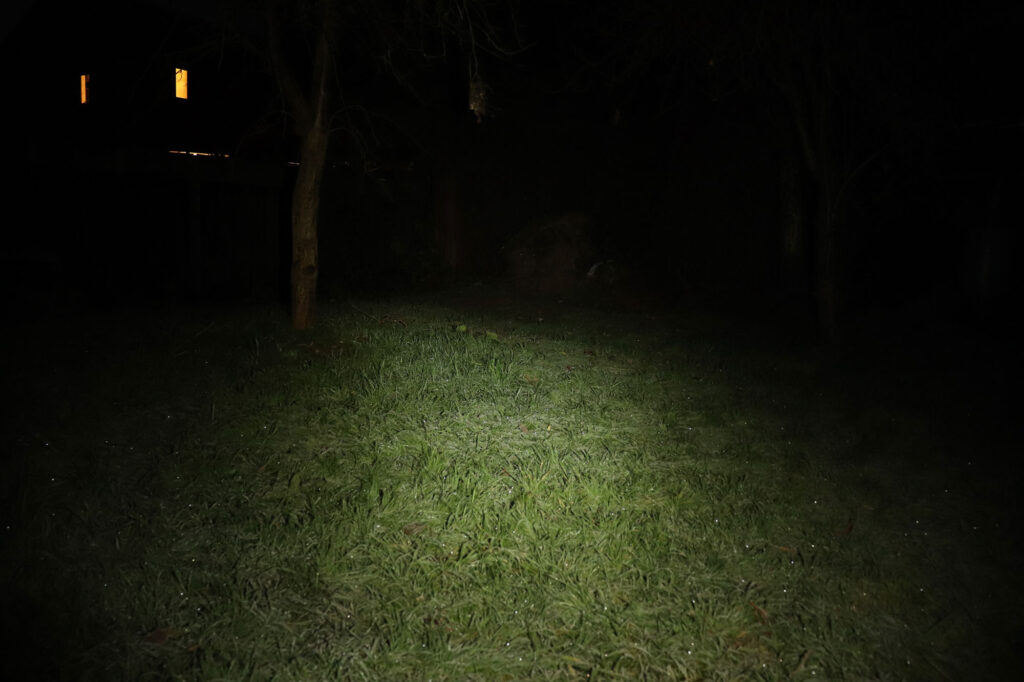
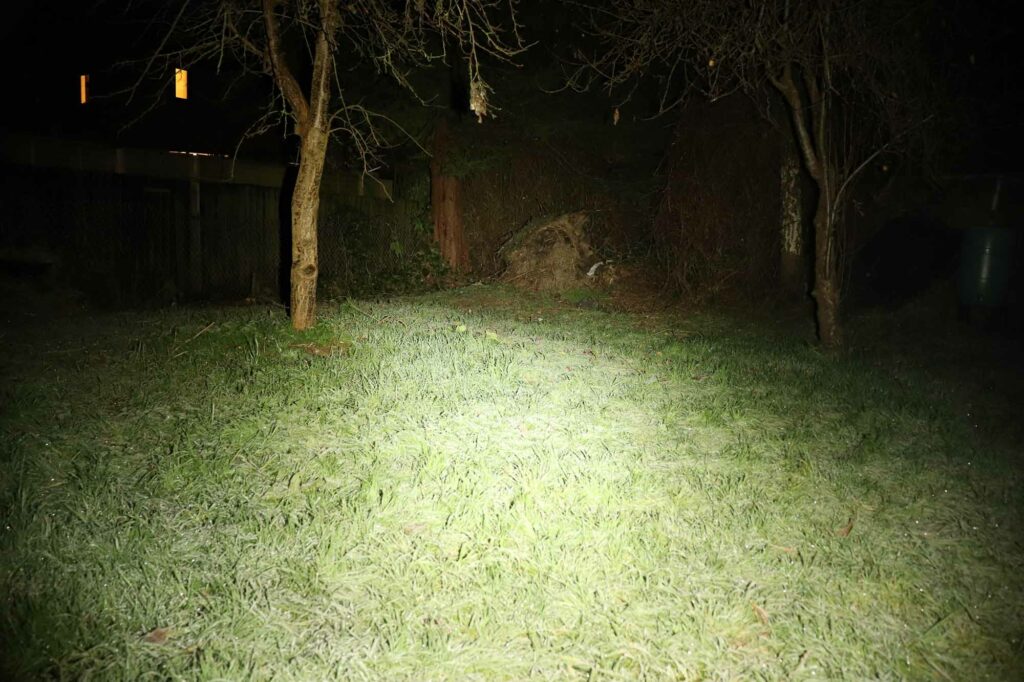
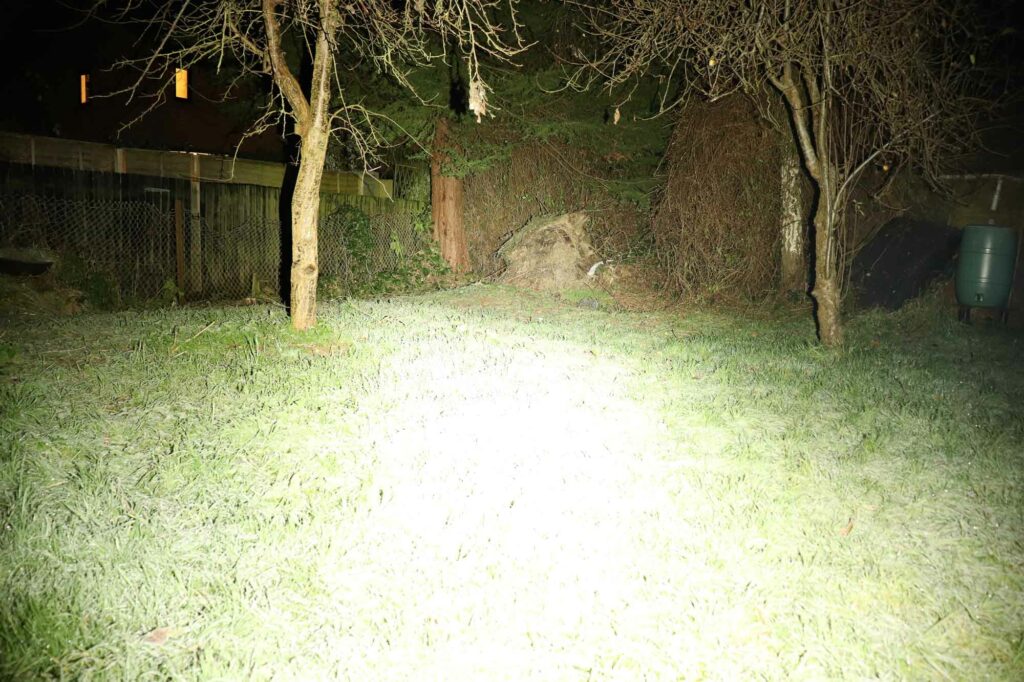
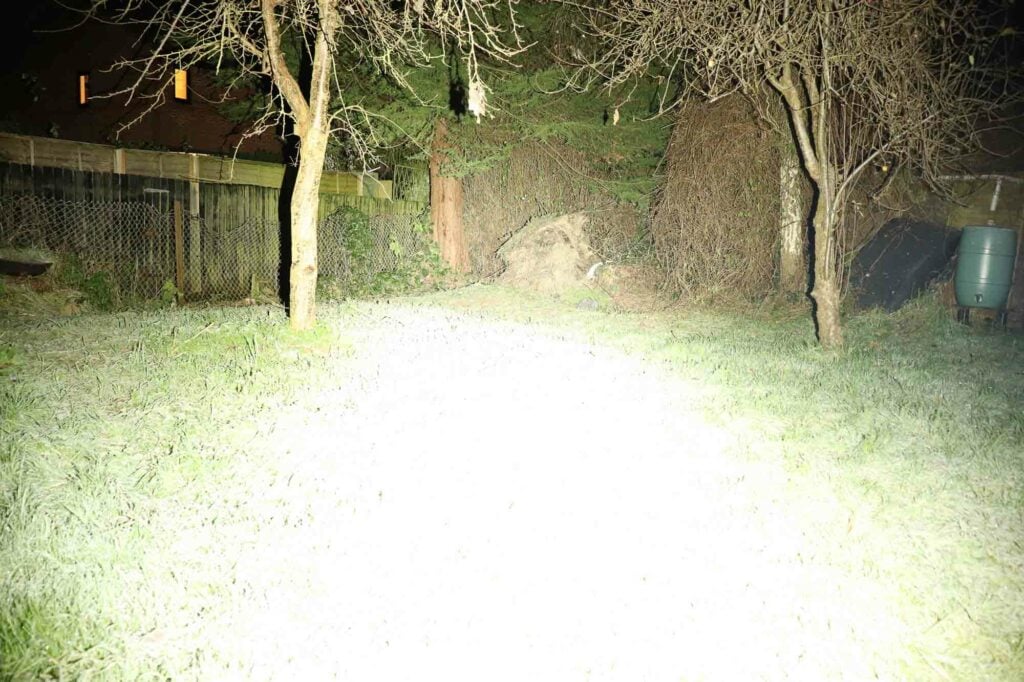
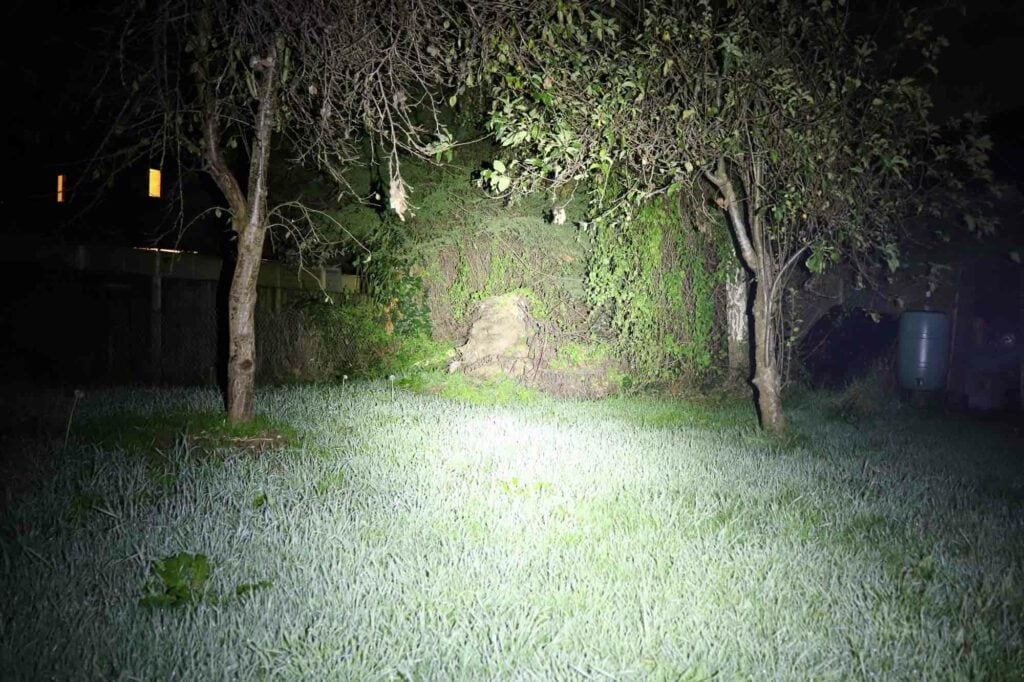
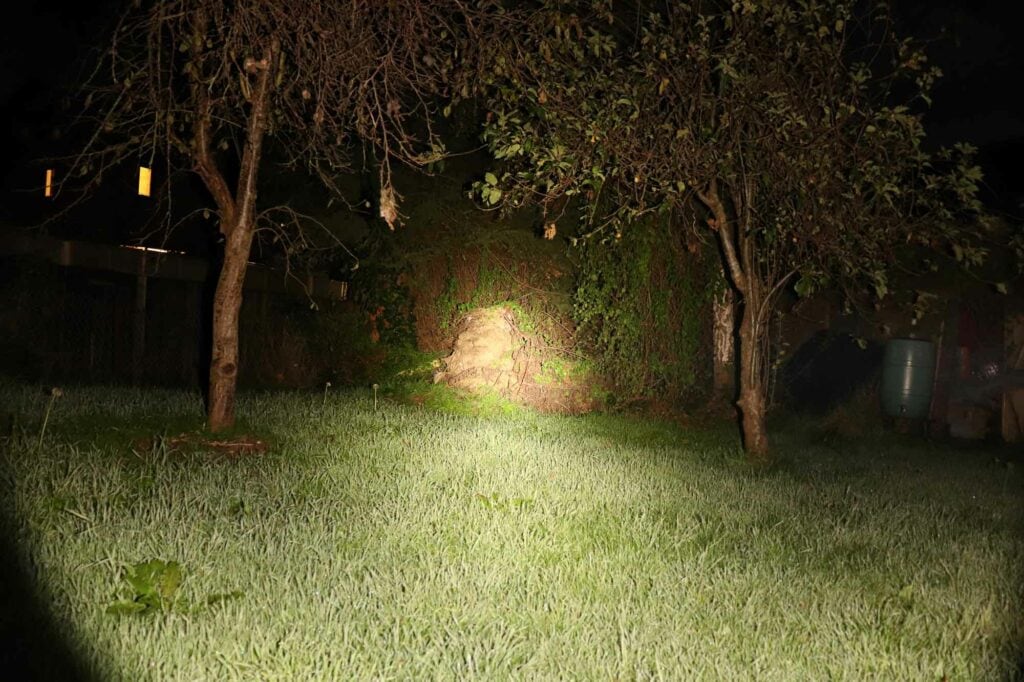
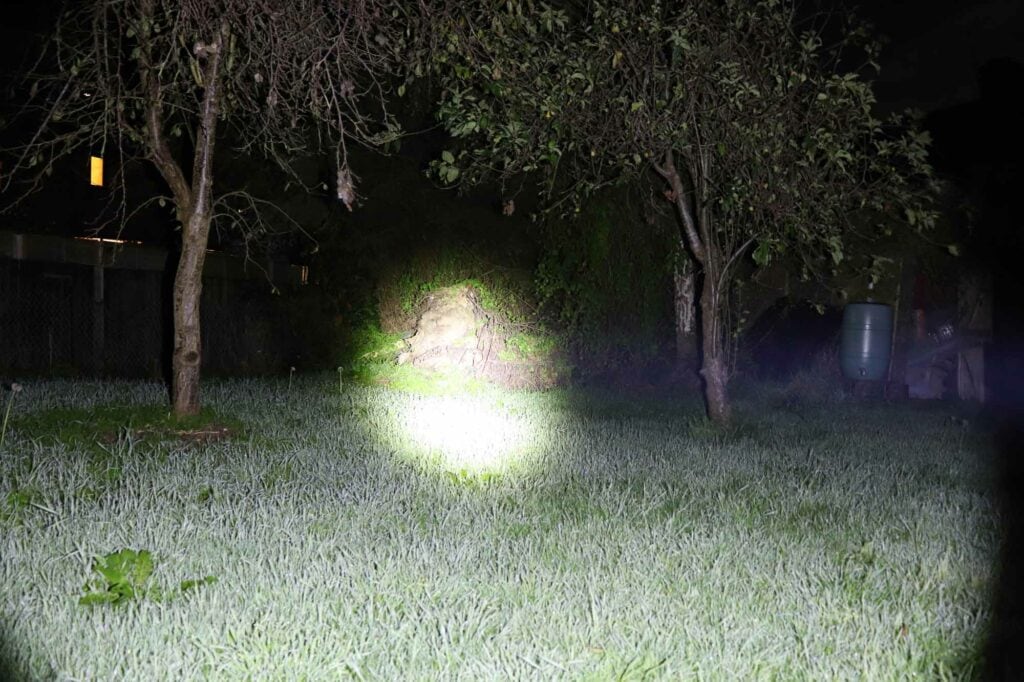
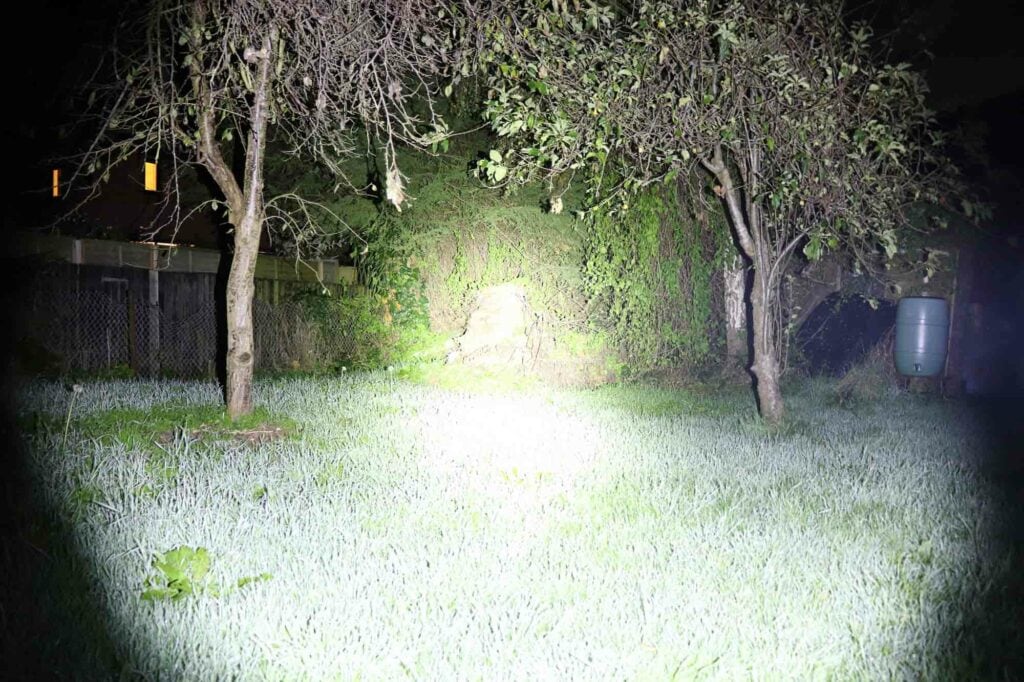
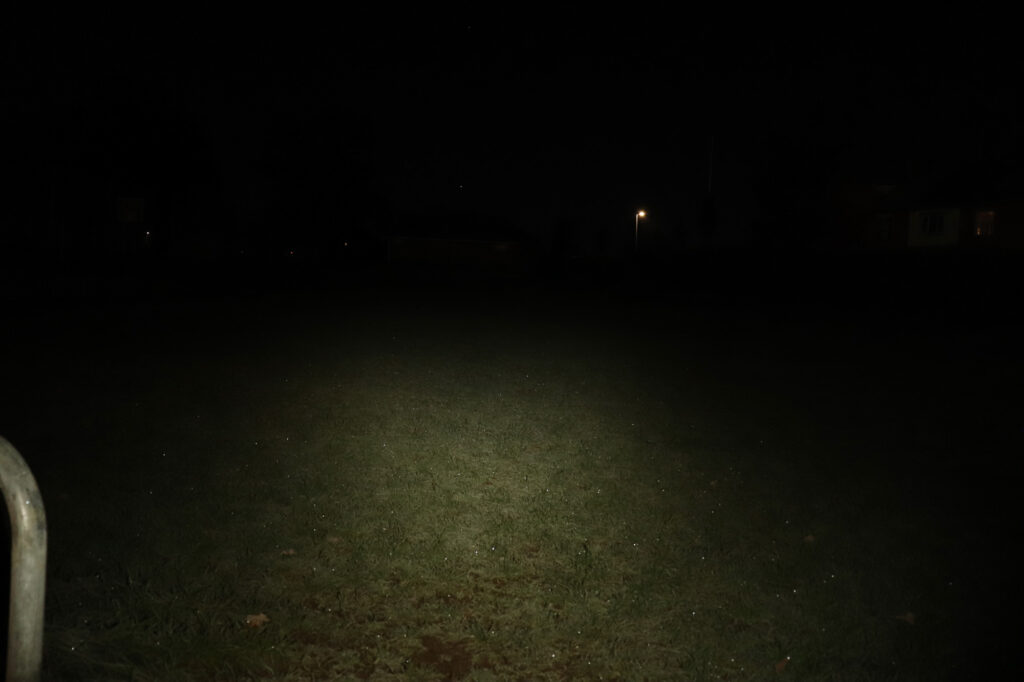
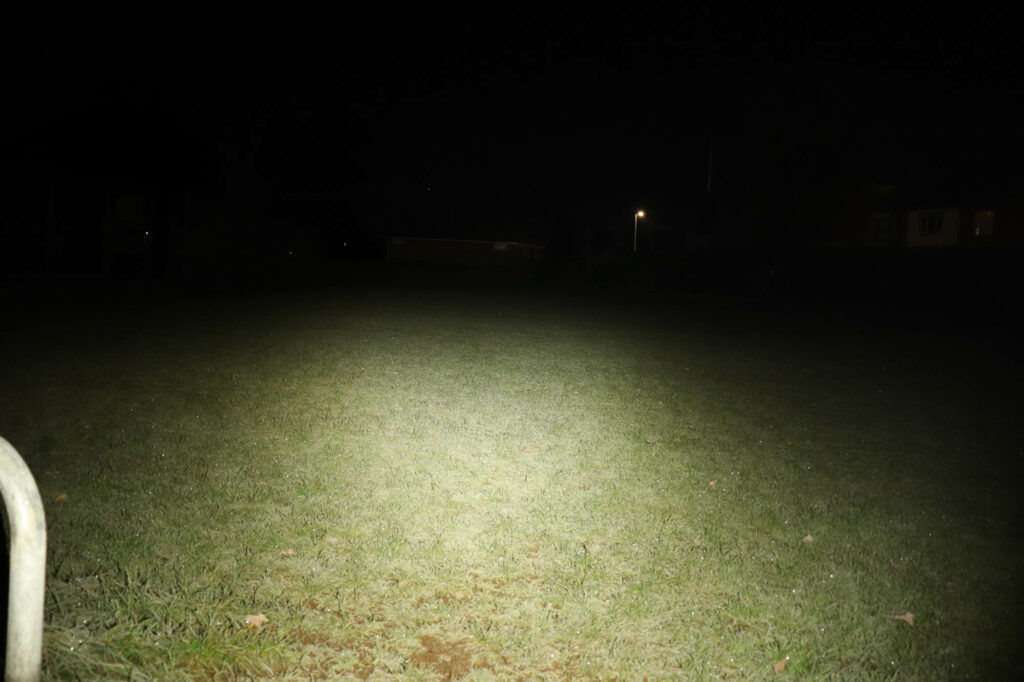
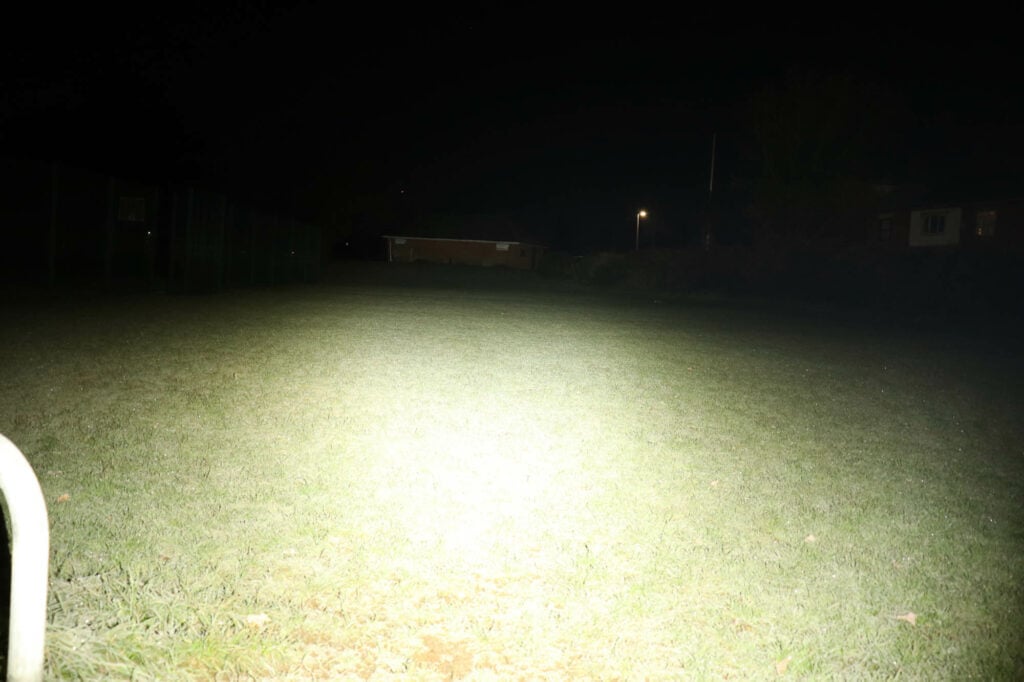
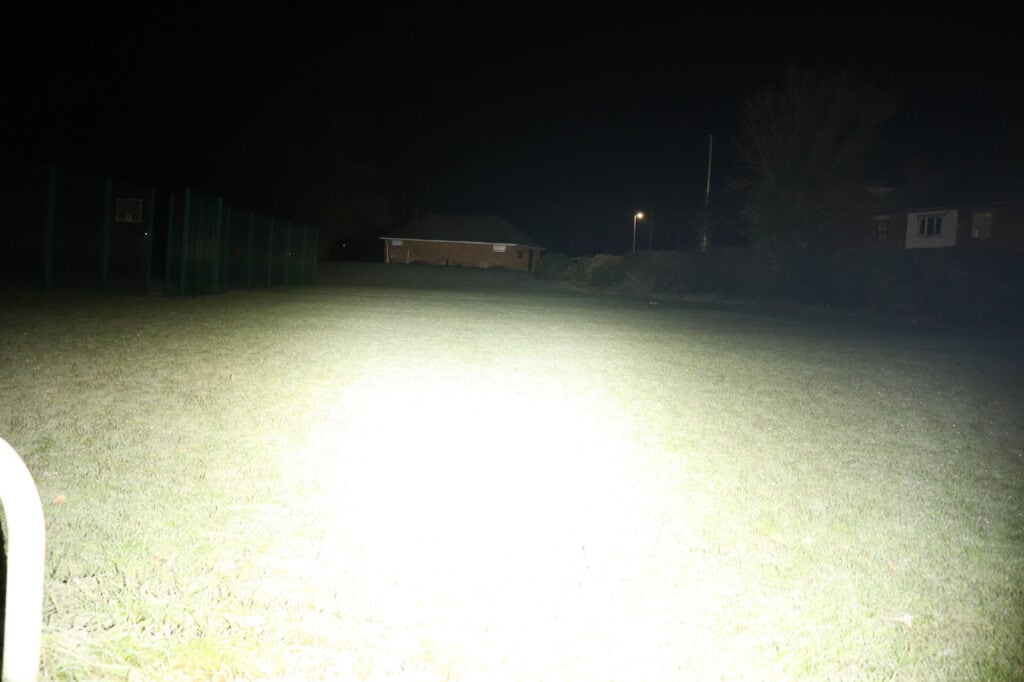
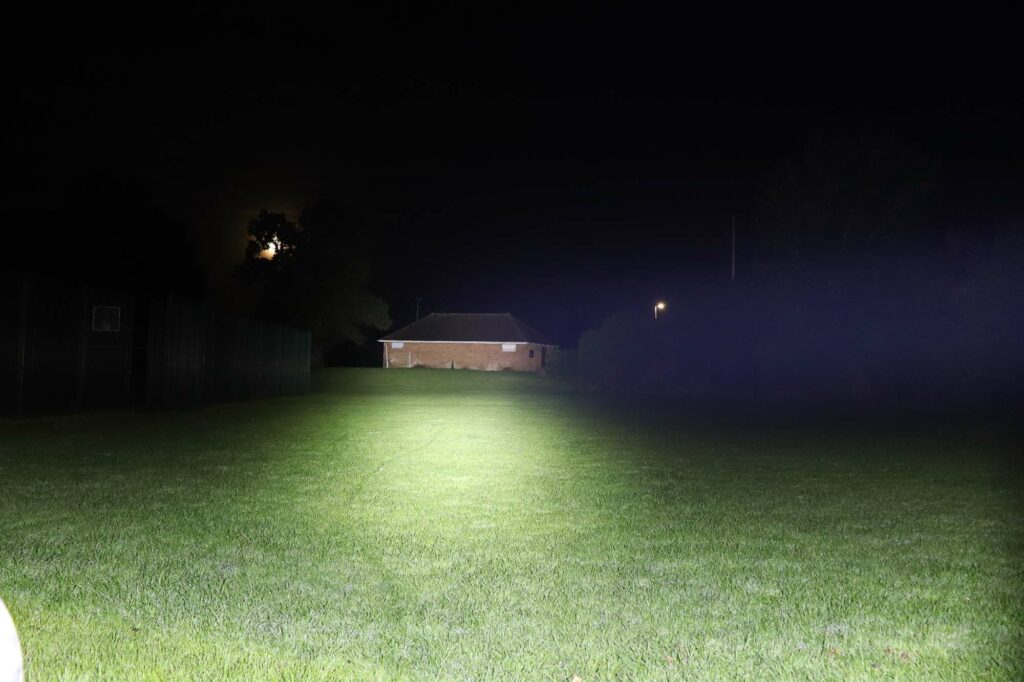
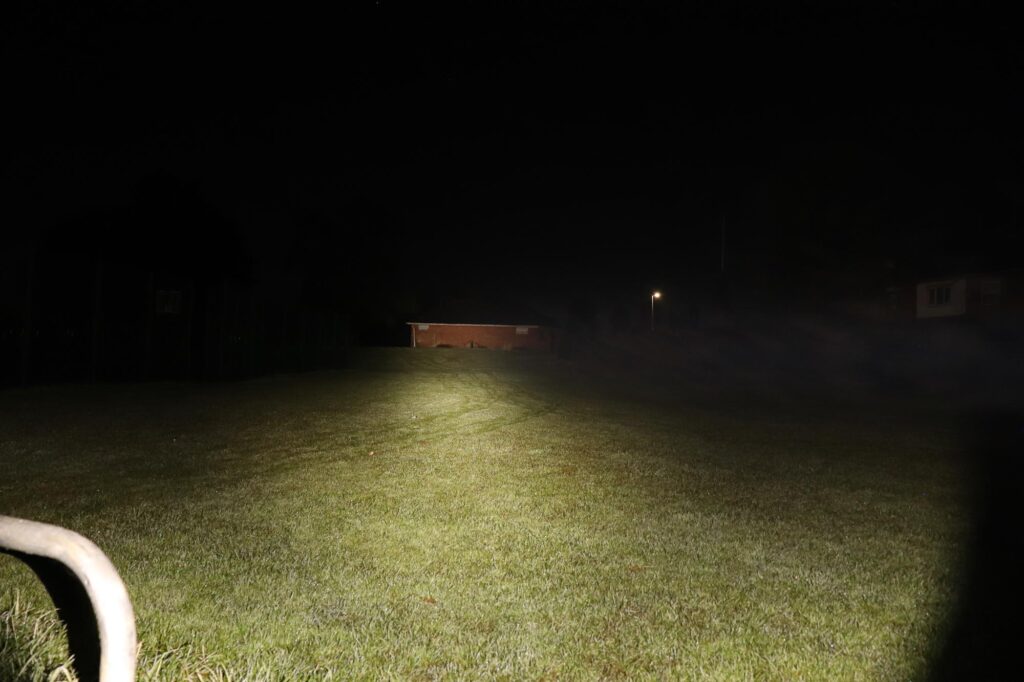
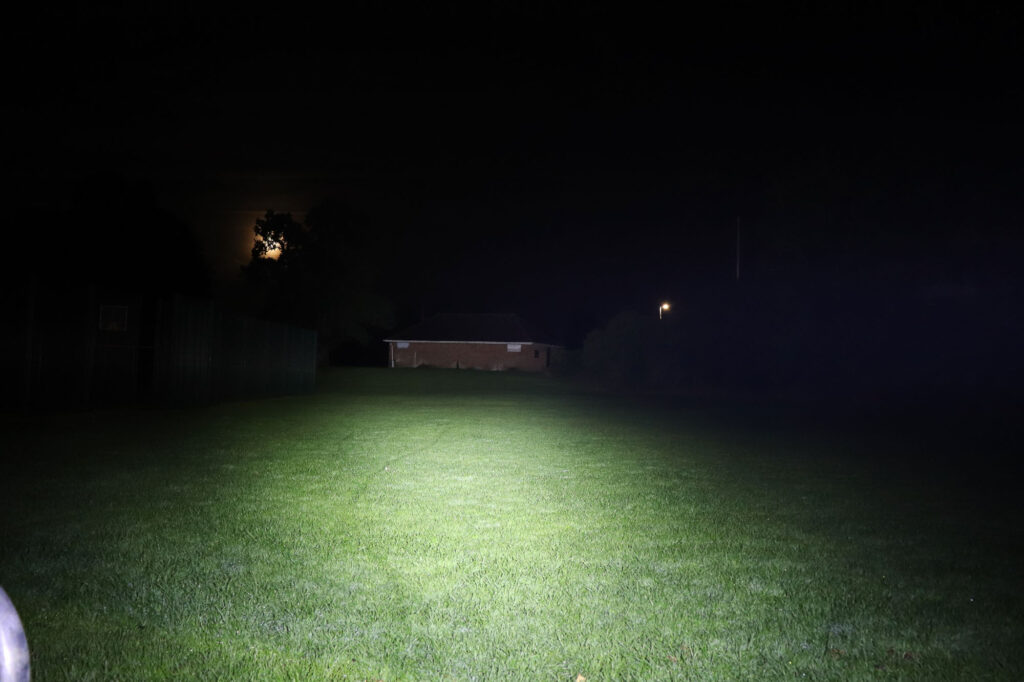
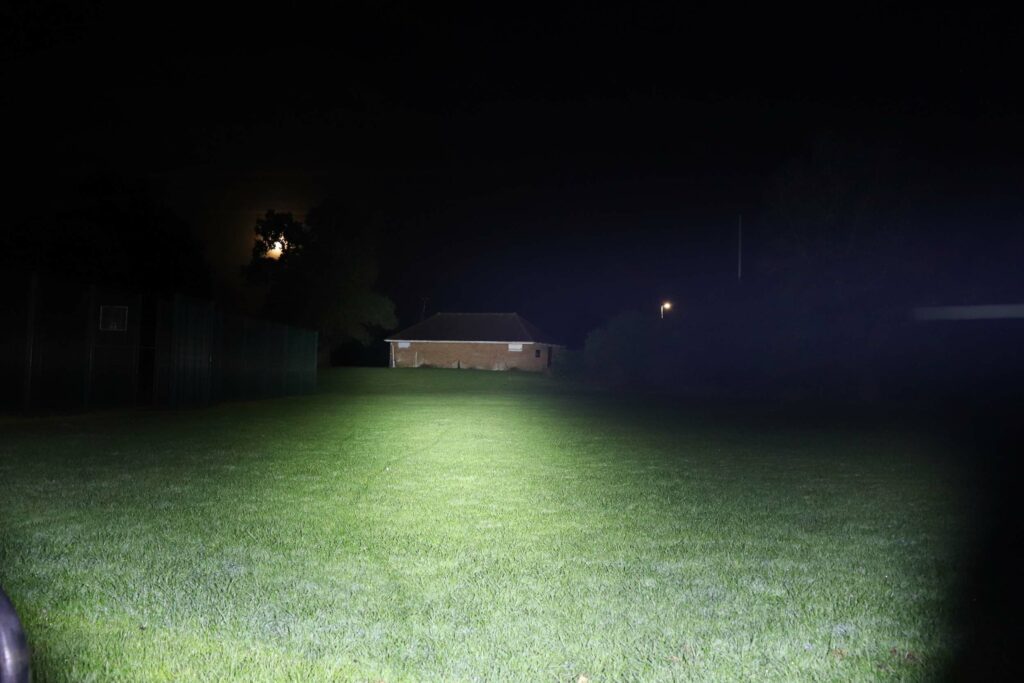
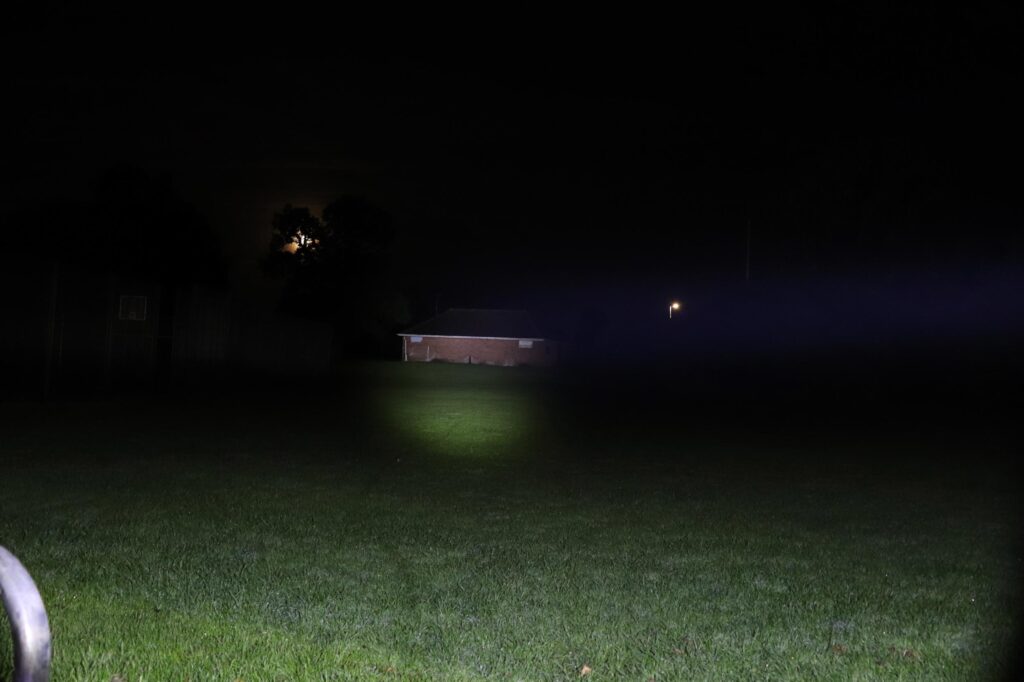
Disclaimer: This flashlight was sent to us for review at no cost by Wurkkos. We have not been paid to review, nor have we been holding back on problems or defects.
Final Verdict
Pros
- Switch & usability
- User interface
- Beam & performance
- Build & design
- Regulation
Cons
- Autolock
- Green switch light
- Very aggressive knurling/grip
- Slightly odd tint
- Eco too bright to be a Moonlight
Explanation on star ratings:
1: Avoid: a match would be a better choice – 2: Poor: significant defect or issues; almost unusable – 3: Average: some defects or issues; but still usable 4: Good: recommended (minor issues) – 5: Great: highly recommended

4.5 stars: ★★★★⋆
While our star rating provides a reliable indicator, we encourage you to read the full review to make an informed decision based on your own needs and preferences.
The confusing LED details, UI niggles and rough knurling shouldn’t detract you from what is actually a very capable and good light. These items do hold back what could have otherwise been a perfect score. But the TS22 is ultimately a really good EDC light with a pleasant UI and good beam. It is certainly one I’d recommend and will be part of my regular EDC rotation of pocket lights. A solid 4.5 stars out of 5 from me.
Buy your Wurkkos TS22 here:
1lumen selects and reviews products personally. We may earn affiliate commissions through our links, which help support our testing.